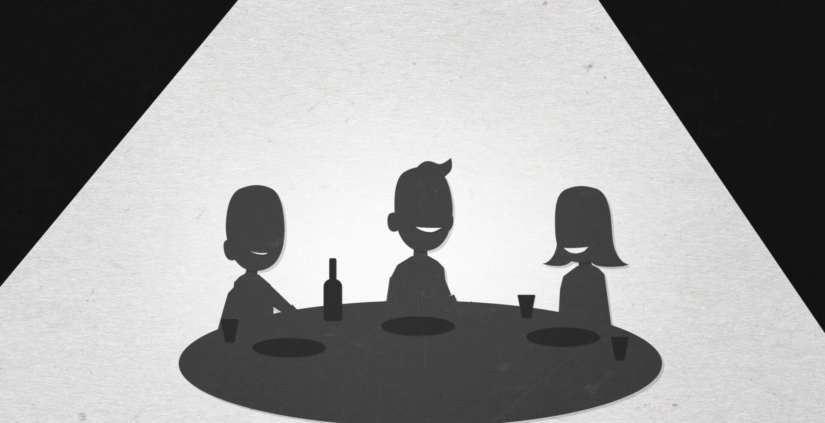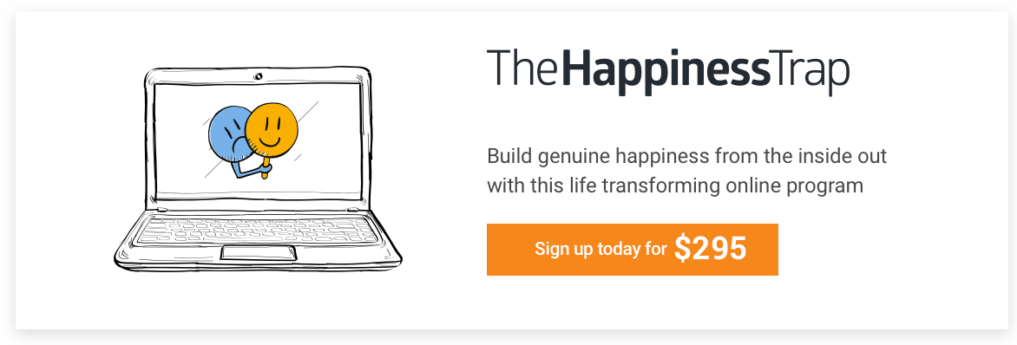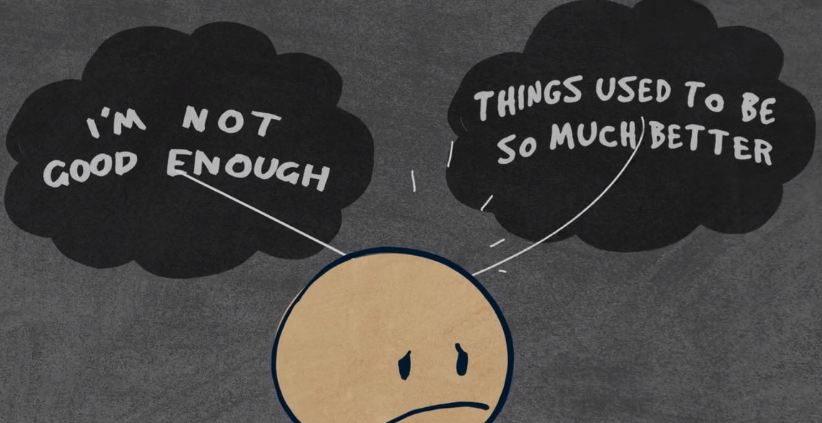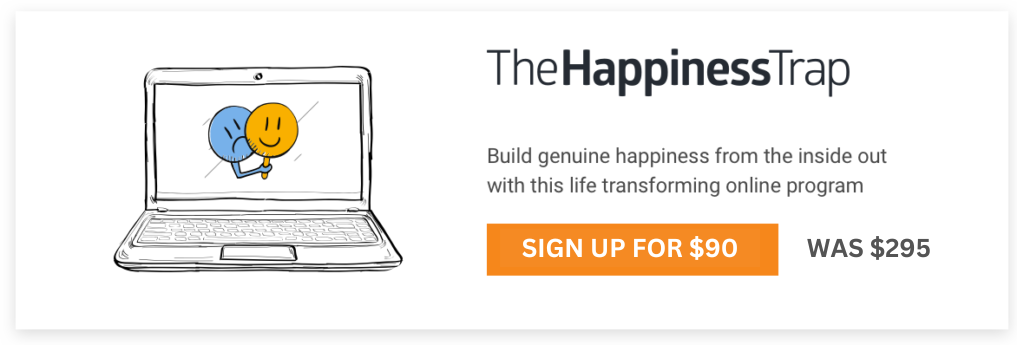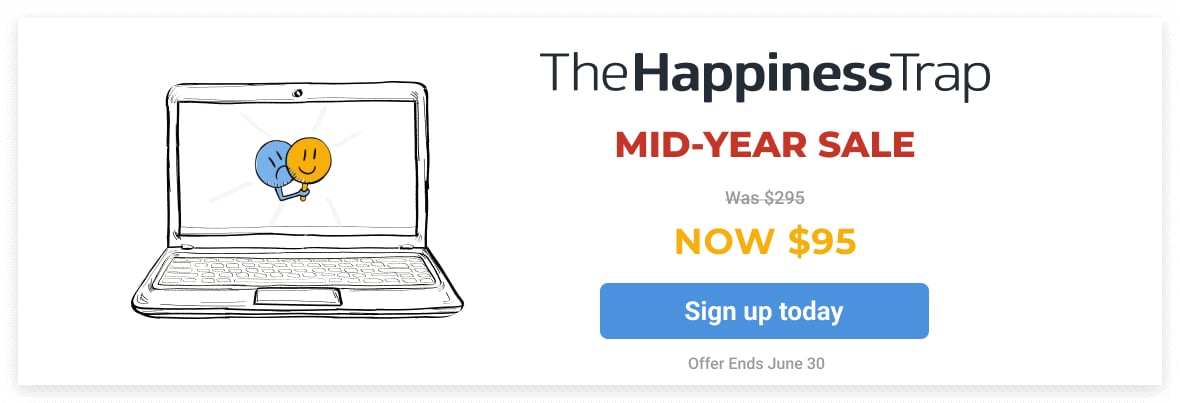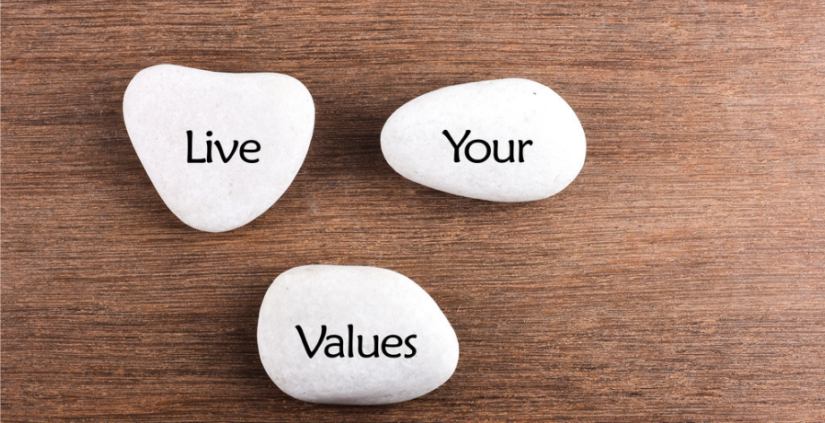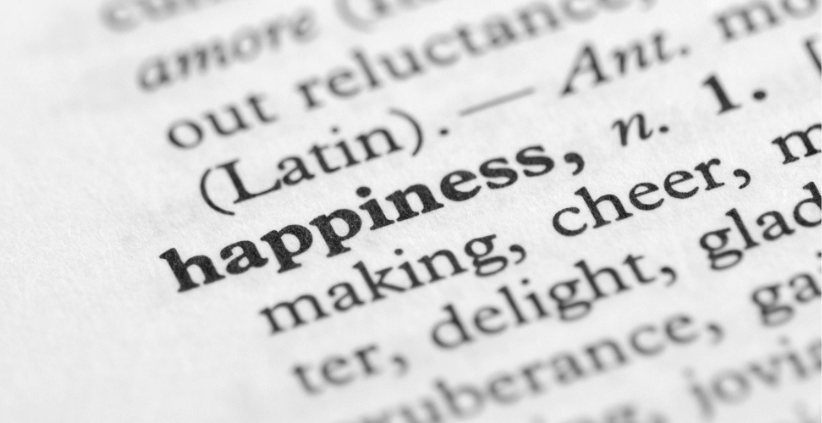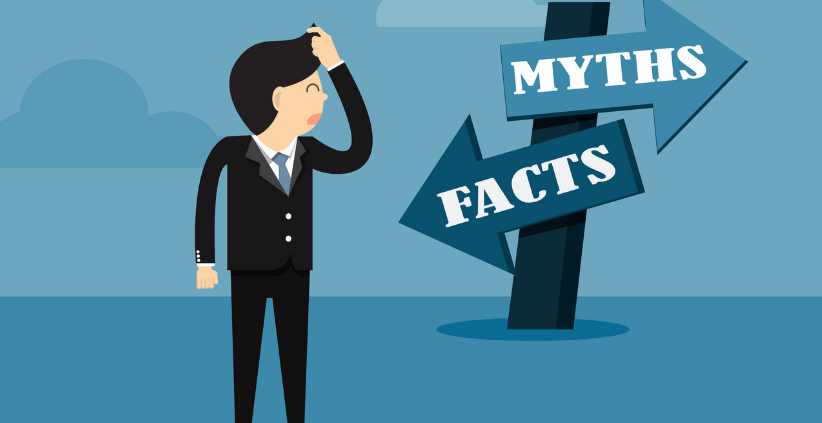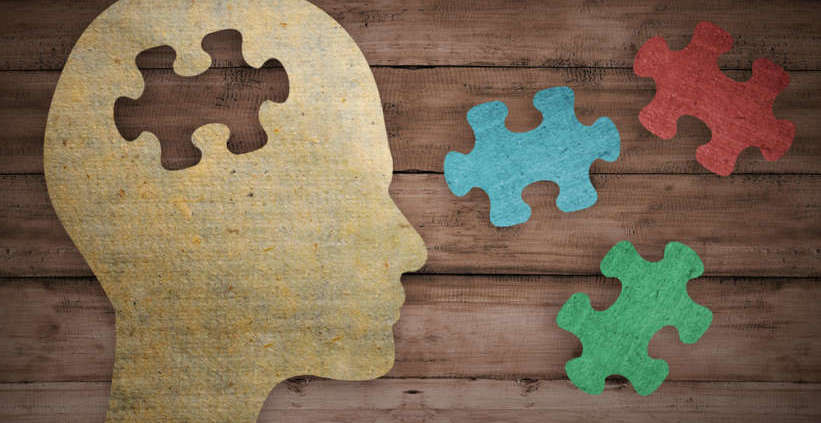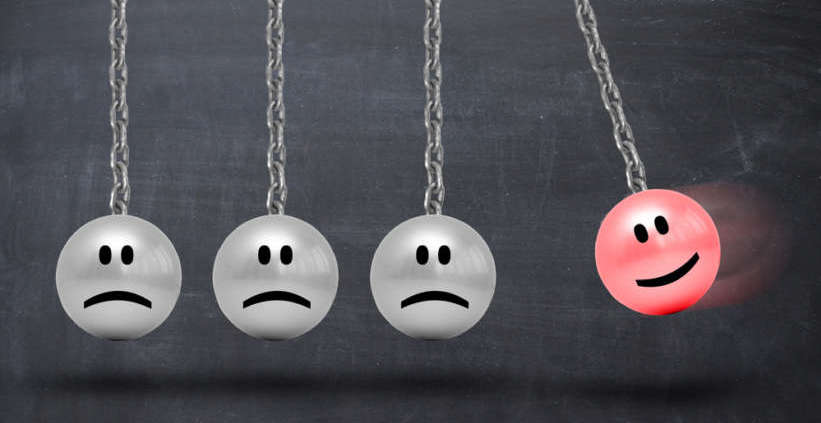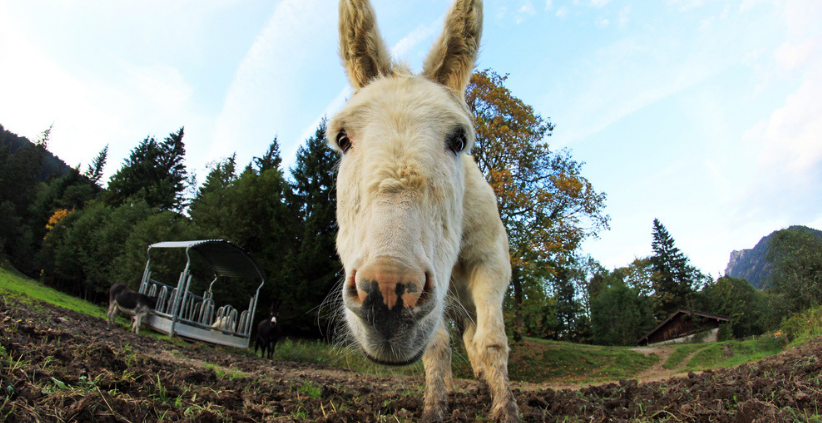The Stageshow Metaphor
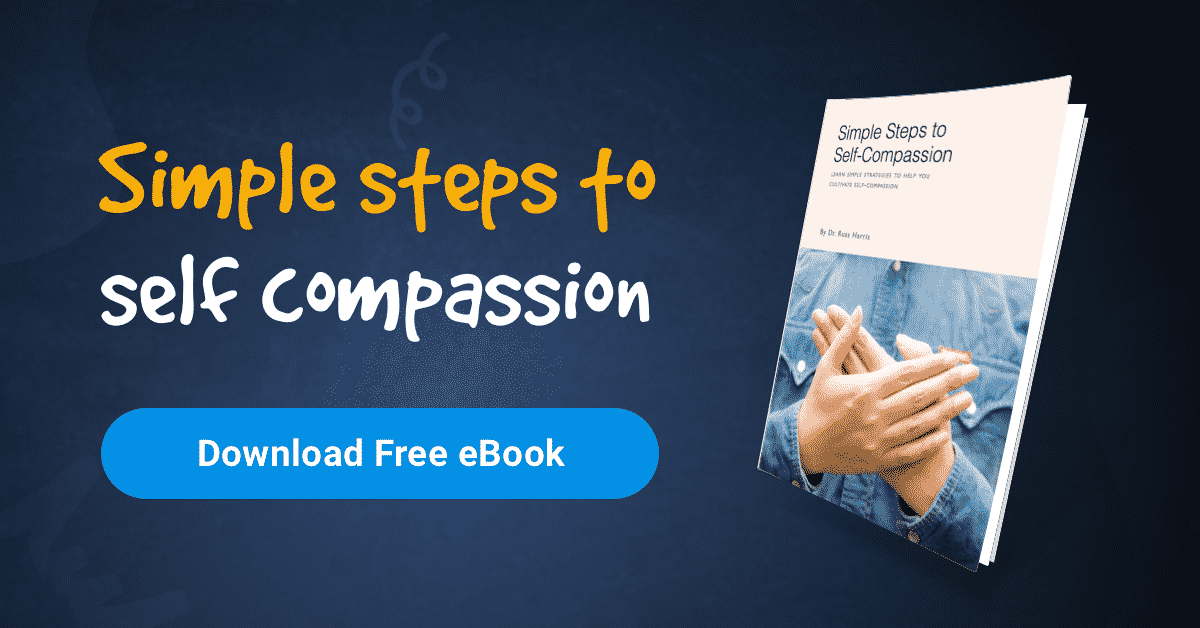
Missing Out
What might happen if we engaged fully on all of those things we do on autopilot each day? Learn more in this clip from the Happiness Trap Online Program.

What is Self Compassion?
Self-compassion means treating ourselves with the same warmth, caring and kindness that we’d extend to someone we love or deeply care about, if they were experiencing challenges, obstacles or difficulties in life.
Self compassion is an important skill to cultivate. Research has shown a positive correlation between self-compassion and psychological well-being, including emotional intelligence, social connectedness and overall life satisfaction.
Learn more about self compassion in this blog article from Russ, The No BS Guide to Self-Compassion, or check out the video below.
We can think of mindfulness as a psychological toolkit for enhancing your health, wellbeing and life.
And there are many different tools within this kit – which serve a variety of different purposes. For example, there are tools which help you to:
- Focus, and refocus, your attention on the task or activity you are doing, and engage in it fully (focusing & engaging skills);
- Detach or unhook from difficult or unhelpful thoughts (unhooking or defusion skills);
- Savour, appreciate and enhance the satisfaction of enjoyable and pleasurable experiences (savouring skills).
All these different skills have one common factor: they all involve paying attention in a particular way, with an attitude of openness, curiosity, and flexibility. In this quick video, Russ shares four whacky techniques to help you unhook from difficult thoughts and feelings.
4 Happiness Myths
Extract from the Happiness Trap, by Dr. Russ Harris.
Myth No. 1: Happiness Is The Natural State For All Human Beings
Our culture insists that humans are naturally happy.
Remember, one in ten adults will attempt suicide, and one in five will suffer from depression.
What’s more, the statistical probability that you will suffer from a psychiatric disorder at some stage in your life is almost 30 per cent! Not exactly great odds, are they?
And when you add in all the misery caused by problems that are not classified as psychiatric disorders — loneliness, divorce, sexual difficulties, work stress, midlife crisis, relationship issues, domestic violence, social isolation, bullying, prejudice, low self-esteem, chronic anger and lack of meaning or purpose in life — you start to get some idea of just how rare true happiness really is.
Unfortunately, many people walk around with the belief that everyone else is happy except for them. And — you guessed it — this belief creates even more unhappiness.
Myth No. 2: If You’re Not Happy, You’re Defective
Following logically from Myth 1, western society assumes that mental suffering is abnormal. It is seen as a weakness or illness, a product of a mind that is somehow faulty or defective.
This means that when we do inevitably experience painful thoughts and feelings, we often criticise ourselves for being weak or stupid.
Health professionals contribute to this process by readily slapping on labels such as, ‘You’re depressed’, and these labels merely confirm how defective we are.
Acceptance and Commitment Therapy is based on a dramatically different assumption. ACT proposes that the normal thinking processes of a healthy human mind will naturally lead to psychological suffering.
You’re not defective — your mind’s just doing its job; the thing it evolved to do. Fortunately, ACT can teach you how to adapt to this in such a way that your life will be powerfully transformed.
Myth No. 3: To Create A Better Life, We Must Get Rid Of Negative Feelings
We live in a feel-good society, a culture thoroughly obsessed with finding happiness. And what does that society tell us to do? To eliminate ‘negative’ feelings and accumulate ‘positive’ ones in their place. It’s a nice theory and on the surface it seems to make sense.
After all, who wants to have unpleasant feelings? But here’s the catch: the things we generally value most in life bring with them a whole range of feelings, both pleasant and unpleasant.
For example, in an intimate long-term relationship, although you will experience wonderful feelings such as love and joy, you will also inevitably experience disappointment and frustration.
There is no such thing as the perfect partner and sooner or later conflicts of interest will happen.
The same holds true for just about every meaningful project we embark on. Although they often bring feelings of excitement and enthusiasm, they also generally bring stress, fear and anxiety.
So if you believe Myth 3, you’re in big trouble, because it’s pretty well impossible to create a better life if you’re not prepared to have some uncomfortable feelings.
Myth No. 4: You Should Be Able To Control What You Think And Feel
The fact is, we have much less control over our thoughts and feelings than we would like. It’s not that we have no control; it’s just that we have much less than the ‘experts’ would have us believe. However, we do have a huge amount of control over our actions.
And it’s through taking action that we create a rich, full and meaningful life. (That’s why we say ACT as the word ‘act’, rather than as the initials A.C.T.)
The overwhelming majority of self-help programs subscribe to Myth 4.
For example, many approaches teach you to identify negative thoughts and replace them with more positive ones.
Other approaches encourage the repetition of positive affirmations such as, ‘Everything that happens is for my highest good and greatest joy’, or ‘I am strong, able and capable at all times’.
Still other approaches encourage you to visualise what you want, to vividly imagine yourself the way you want to be, living the life you dream of.
The basic theme of all these approaches is this: if you challenge your negative thoughts or images and, instead, repeatedly fill your head with positive thoughts and images, you will find happiness. If only life were that simple! I’m willing to bet that you’ve already tried countless times to think more positively about things and yet those negative thoughts keep coming back again and again.
Our minds have evolved over a hundred thousand years to think the way they do, so it’s not likely that a few positive thoughts or affirmations will change them all that much!
It’s not that these techniques have no effect; they can often make you feel better temporarily.
But they will not get rid of negative thoughts over the long term.
The same holds true for ‘negative’ feelings such as anger, fear, sadness, insecurity and guilt.
There are multitudes of psychological strategies to ‘get rid of’ such feelings. But you’ve undoubtedly discovered that even if they go away, after a while they’re back. And then they go away again.
And then they come back again. And so on and so on. The likelihood is, if you’re like most other humans on the planet, you’ve already spent a lot of time and effort trying to have ‘good’ feelings instead of ‘bad’ ones — and you’ve probably found that as long as you’re not too distressed, you can, to some degree, pull it off.
But you’ve probably also discovered that as your level of distress increases, your ability to control your feelings progressively lessens. Sadly, Myth 4 is so widely believed that we tend to feel inadequate when our attempts to control our thoughts and feelings fail.
These four powerful myths provide the basic blueprint for the happiness trap.
They set us up for a struggle we can never win: the struggle against our own human nature. It is this struggle that builds the trap.
Chasing Happiness
What’s the most important thing in life? A lot of people, when first asked this question, answer… HAPPINESS!
But did you know, there is a large and growing body of scientific research that shows the harder you try to control the way you feel, the more miserable you are likely to become?
Watch this quick video to learn more.
The Sushi Train Metaphor
The Difference Between a Goals and Values Focused Life
Society tells us the way to be happy is to achieve our goals. But there is a radically different way to live your life. A life based on values.
Watch this quick video to learn more.
The Illusion of Control
Extract from the Happiness Trap, by Dr. Russ Harris
The human mind has given us an enormous advantage as a species. It enables us to make plans, invent things, coordinate actions, analyse problems, share knowledge, learn from our experiences and imagine new futures.
The clothes on your body, the shoes on your feet, the watch on your wrist, the chair beneath you, the roof over your head, the book in your hands — none of these things would exist but for the ingenuity of the human mind.
The mind enables us to shape the world around us and conform it to our wishes, to provide ourselves with warmth, shelter, food, water, protection, sanitation and medicine. Not surprisingly, this amazing ability to control our environment gives us high expectations of control in other arenas as well.
Now, in the material world, control strategies generally work well. If we don’t like something, we figure out how to avoid it or get rid of it, and then we do so. A wolf outside your door? Get rid of it! Throw rocks at it, or spears, or shoot it. Snow, rain or hail?
Well you can’t get rid of those things, but you can avoid them by hiding in a cave, or building a shelter. Dry, arid ground? You can get rid of it by irrigation and fertilisation, or you can avoid it by moving to a better location.
But what about our internal world? I’m talking here about thoughts, memories, emotions, urges, mental images and physical sensations. Can we simply avoid or get rid of the ones we don’t like?
In the outer world, we can do so fairly easily, so shouldn’t it be the same with our inner world? Here’s a little experiment. As you keep reading this paragraph, try not to think about ice cream. Don’t think about the colour or the texture or the taste of it. Don’t think about how it tastes on a hot summer’s day.
Don’t think about how good it feels as it melts inside your mouth. Don’t think about how you have to keep licking around the edges to stop it from dripping on your fingers.
How’d you do?
Exactly! You couldn’t stop thinking about ice cream. Here’s another little experiment. Recall something that happened in the past week. Any memory will do, whether it’s a conversation you had, a movie you watched or a meal you ate. Got one? Good.
Now try to get rid of it. Totally obliterate it from your memory so it can never come back to you, ever again. How did you go? If you think you succeeded, just check again and see if you can still remember it.
Now, tune in to your mouth. Notice how your tongue feels. Run it over your teeth, your gums, your cheeks and the roof of your mouth. Now try to get rid of those sensations. Try to turn your mouth totally numb, as if you just had a shot of novocaine from the dentist. Were you able to forget the sensations?
Now consider this hypothetical scenario for a moment. Suppose someone put a loaded gun to your head and told you that you must not feel afraid; that if you should feel even the slightest trace of anxiety, they will shoot you.
Could you stop yourself feeling anxious in this situation, even though your life depended on it?
(Sure you could try to act calm, but could you truly feel it?)
Okay, one last experiment. Stare at the star below then see if you can stop yourself from thinking for 60 seconds.

That’s all you have to do. For 60 seconds, prevent any thoughts whatsoever from coming into your mind — especially any thoughts about the star!
Hopefully by now you’re getting the point that thoughts, feelings, physical sensations and memories are just not that easy to control. It’s not that you have no control over these things; it’s just that you have much less control than you thought.
Let’s face it, if these things were that easy to control, wouldn’t we all just live in perpetual bliss? Of course, there are a few self-help gurus who claim to live in such a state all the time. Such people often get really rich, their books sell by the million and they attract huge followings of people desperate for ‘the answer’.
My guess is that many readers of this book will have already gone down that path and been sadly disappointed.
What Exactly is Happiness?
Extract from the Happiness Trap by Dr. Russ Harris
We all want it. We all crave it. We all strive for it.
Even the Dalai Lama has said: ‘The very purpose of life is to seek happiness.’ But what exactly is this elusive thing we are looking for?
The word ‘happiness’ has two very different meanings. Usually it refers to a feeling: a sense of pleasure, gladness or gratification.
We all enjoy happy feelings, so it’s no surprise that we chase them. However, like all our other feelings, feelings of happiness don’t last. No matter how hard we try to hold on to them, they slip away every time.
And as we shall see, a life spent in pursuit of those feelings is, in the main, unsatisfying.
In fact, the harder we pursue pleasurable feelings, the more we are likely to suffer from anxiety and depression. The other meaning of happiness is ‘a rich, full and meaningful life’.
When we take action on the things that truly matter deep in our hearts, when we move in directions that we consider valuable and worthy, when we clarify what we stand for in life and act accordingly, then our lives become rich and full and meaningful, and we experience a powerful sense of vitality.
This is not some fleeting feeling – it is a profound sense of a life well lived. And although such a life will undoubtedly give us many pleasurable feelings, it will also give us uncomfortable ones, such as sadness, fear and anger.
This is only to be expected. If we live a full life, we will feel the full range of human emotions.
In the book, The Happiness Trap, as you’ve probably guessed by now, we are far more interested in the second meaning of happiness than in the first.
Of course, happy feelings are quite pleasant, and we should certainly make the most of them when they present themselves. But if we try to have them all the time, we are doomed to failure.
The reality is, life involves pain. There’s no getting away from it. As human beings we are all faced with the fact that sooner or later we will grow infirm, get sick and die. Sooner or later we all will lose valued relationships through rejection, separation or death.
Sooner or later we all will come face-to-face with a crisis, disappointment and failure. This means that in one form or another, we are all going to experience painful thoughts and feelings.
The good news is that, although we can’t avoid such pain, we can learn to handle it much better – to make room for it, rise above it and create a life worth living.
Values vs Goals
Will getting that great job or house really make you happier?
In this fun and entertaining video, Russ explains the important distinction between living a goals-focused vs a values-focused life and why living in accordance with your innermost values can lead to a more rich, full, and meaningful life.
The 3 Happiness Myths
The 3 Happiness Myths [Video]
This entertaining animation illustrates the 3 happiness myths that we have been lead to believe, involving our thoughts and feelings.
Evolution of the Human Mind
Evolution of the Human Mind [Video]
Ever wondered why the human mind has evolved in the manner that it has?
This quick video from Dr. Russ Harris explains all!
Why Is It So Difficult to Be Happy?
Extract from The Happiness Trap, written by Dr. Russ Harris
To answer this question, we need to take a journey back in time. The modern human mind, with its amazing ability to analyse, plan, create and communicate, has largely evolved over the last hundred thousand years, since our species, Homo sapiens, first appeared on the planet.
But our minds did not evolve to make us feel good, so we could tell great jokes, write sonnets and say ‘I love you’.
Our minds evolved to help us survive in a world fraught with danger. Imagine that you’re an early human hunter–gatherer. What are your essential needs in order to survive and reproduce?
There are four of them: food, water, shelter and sex, but none of these things mean much if you’re dead. So the number one priority of the primitive human mind was to look out for anything that might harm you and avoid it!
In essence, the primitive mind was a ‘Don’t get killed’ device, and it proved enormously useful. The better our ancestors became at anticipating and avoiding danger, the longer they lived and the more children they had. With each generation the human mind became increasingly skilled at predicting and avoiding danger.
And now, after a hundred thousand years of evolution, the modern mind is still constantly on the lookout for trouble. It assesses and judges almost everything we encounter: Is this good or bad? Safe or dangerous? Harmful or helpful?
These days, though, it’s not sabre-toothed cats or 200- kilogram wolves that our mind warns us about. Instead it’s losing our job, being rejected, getting a speeding ticket, not being able to pay the bills, embarrassing ourselves in public, upsetting our loved ones, getting cancer, or any of a million and one other common worries.
As a result we spend a lot of time worrying about things that, more often than not, never happen. Another essential for the survival of any early human is to belong to a group. If your clan boots you out, it won’t be long before the wolves find you. So how does the mind protect you from rejection by the group? By comparing you with other members of the clan:
Am I fitting in? Am I doing the right thing? Am I contributing enough? Am I as good as the others? Am I doing anything that might get me rejected?
Sound familiar? Our modern-day minds are continually warning us of rejection and comparing us against the rest of society. No wonder we spend so much energy worrying whether people will like us! No wonder we’re always looking for ways to improve ourselves or putting ourselves down because we don’t ‘measure up’.
A hundred thousand years ago we had only the few members of our immediate clan to compare ourselves with. But these days we can open any newspaper or magazine, switch on any television, tune in to any radio, and instantly find a whole host of people who are smarter, richer, taller, slimmer, sexier, stronger, more powerful, more famous, more successful, or more admired than we are. What’s the fastest way to make a teenage girl depressed?
Show her a fashion magazine. When she compares herself to all those air-brushed, collagen-enhanced, digitally altered supermodels, she is guaranteed to feel inferior or downright unattractive.
And the rest of us are not that different. Thanks to evolution, our minds are now so sophisticated they can even dream up a fantasy of the person we’d like to be — and then compare our ‘real’ self to that impossible standard. What chance have we got? We will always end up feeling not good enough!
Now, for any Stone Age person with ambition, the general rule for success is: the more, the better. The more sophisticated your weapons (and the more of them you have), the more food you can kill. The more plentiful your food stores, the better your chances are for living through times of scarcity. The more substantial your shelter, the safer you are from weather and wild animals.
The more children you have, the better the chance that some of them will survive into adulthood. No surprise then, that our modern mind continually looks for more: more money, more status, more love, more job satisfaction, a newer car, a younger-looking body, a younger-looking partner, a bigger house. And if we succeed, if we actually get more money or a newer car or a better job, then we’re satisfied — for a while. But sooner or later (and usually sooner), we end up wanting more.
Thus, evolution has shaped our minds so that we are almost inevitably destined to suffer psychologically: to compare, evaluateand criticise ourselves; to focus on what we’re lacking; to be dissatisfied with what we have; and to imagine all sorts of frightening scenarios, most of which will never happen.
No wonder humans find it hard to be happy!
Does Acceptance Mean Settling, Giving Up, Rolling Over?
It’s amazing how often folks misinterpret the word acceptance.
They may think it means ‘settling’, ‘giving up’, ‘rolling over’, ‘putting up with it’, ‘setting the bar low’, ‘giving up my dreams’, or ‘this is my lot in life so suck it up get on with it’.
Of course, like any word, there are different possible interpretations, but as we use the term in The Happiness Trap Online Program, ‘acceptance’ definitely does NOT mean any of those things.
The Happiness Trap program is based on a model known as ACT, Acceptance and Commitment Therapy, and it strongly encourages an attitude that is the complete opposite of settling or giving up and rolling over.
The C in ACT is for Commitment
ACT encourages you to commit to action to do the things that make life rich full and meaningful. if your life sucks and there’s something you can do about it, TAKE ACTION.
Don’t just ‘settle’ or ‘put up with it’; actively change your behaviour. Do things that are likely to improve the situation.
Do Stuff That Improves Your Quality of Life
- Look after your health
- Build healthy relationships
- Develop or change your career
- Change what you do, in little ways and in big ways, to make your life as good as it can be: spend your time doing meaningful activities.
- Set life-enhancing goals and actively pursue them
‘Acceptance’ as we use the term in ACT and The Happiness Trap, means ‘opening up and making room for difficult thoughts and feelings, and allowing them to flow freely through you in their own good time, neither struggling with them nor getting swept away by them.’
I often use the word ‘expansion’ rather than ‘acceptance’, to prevent such confusion. It’s about expanding: opening up and making room inside you for the inevitable painful feelings that life dishes out to all of us.
If you’re in a bad relationship, bad job, bad neighbourhood, bad country, bad situation of any sort – and if it’s realistic to leave, and it seems likely that leaving will make your life better … then it makes sense to leave.
Acceptance doesn’t mean you passively stay and put up with it if and when leaving is possible and likely to make life better; acceptance means opening up and making room for the difficult thoughts and feelings that are guaranteed to show up whether you choose to stay or whether you choose to leave.
So if life is dull, empty, lacking, unfulfilling, or full of problems and stress, then ACT teaches you:
- How to open up and make room for the difficult thoughts and feelings that are showing up (acceptance) and
- At the same time, take action to improve your life; do things, guided by your values, to solve your problems and make life better.
It’s this double-handed approach that helps us to effectively build a rich and full life.
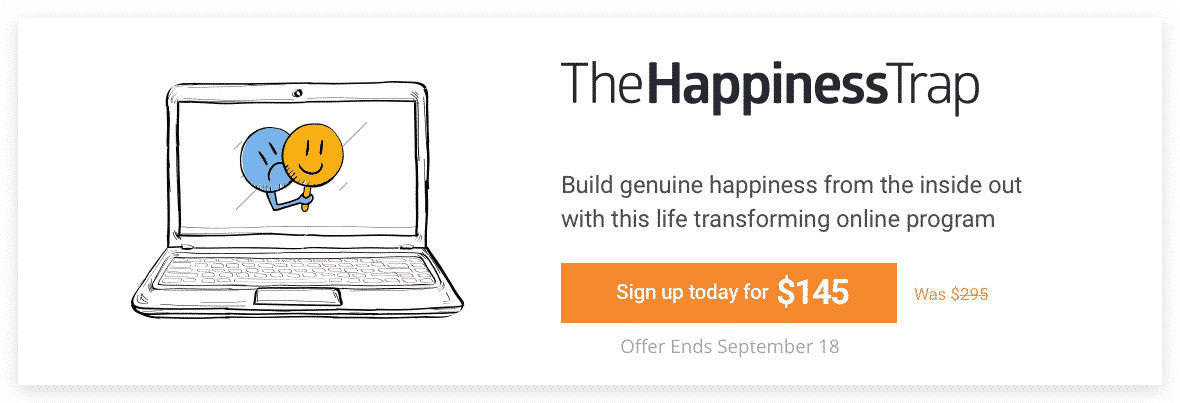
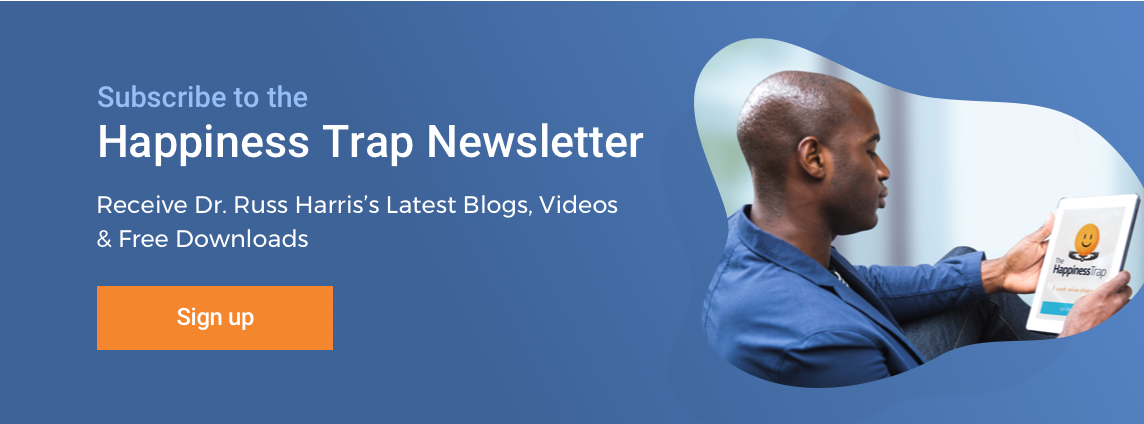
I Don’t Know What to Do With My Life
Has your mind ever hooked you with this question: “I don’t know what to do with my life?”
Mine certainly has, and I can tell you: it’s a recipe for misery. The more you get hooked by this question, the more dissatisfied you become with the life you have.
The problem is, this question is sooooo big, almost nobody can answer it (except for the tiny number of people who have some sort of grand calling or vision for their whole life, which is almost always to do with religion or politics).
For most of us, this is not a useful question to ask; it’s just too big, too overwhelming. Here are some far more helpful questions to ask yourself:
What do I want to do with …
- My evening
- My weekends
- My summer holiday
- The rest of this week
- The rest of this day
- This hour
- This next 10 minutes
- My body – today, tomorrow, next week, next month, next year
- My job/work/career – today, tomorrow, next week, next month, next year
- My finances – today, tomorrow, next week, next month, next year
- My leisure time – today, tomorrow, next week, next month, next year
- My further education or skills development – today, tomorrow, next week, next month, next year
- My friends – today, tomorrow, next week, next month, next year
- My family – today, tomorrow, next week, next month, next year
- My hobbies – today, tomorrow, next week, next month, next year
- My volunteer work – today, tomorrow, next week, next month, next year
Don’t try to answer all these at once; that will also be overwhelming.
Pick one or two to focus on each week. Then, over a period of two or three months, gather your answers.
And come up with your own questions; the ones above are just examples that may or may not be relevant to you.
Make your questions specific, and explore what you want to do short term, medium term, and long term.
And if the answer to any question is “Don’t know” then until such time as you do know, why not make the best of what you are currently doing?
Engage in it fully, appreciate it, do it well, make the most of it.
The Happiness Trap Online Program
The Happiness Trap Online Program is based on an empirically-supported model known as Acceptance and Commitment Therapy (ACT).
Over a 35 year period, evidence has mounted for ACT’s effectiveness in treating conditions including anxiety, chronic pain, depression, stress, smoking, weight loss and performance enhancement.
The Happiness Trap program teaches highly-effective strategies and interventions based on the ACT model, which can help you stop struggling with difficult thoughts and feelings and build genuine and lasting happiness.

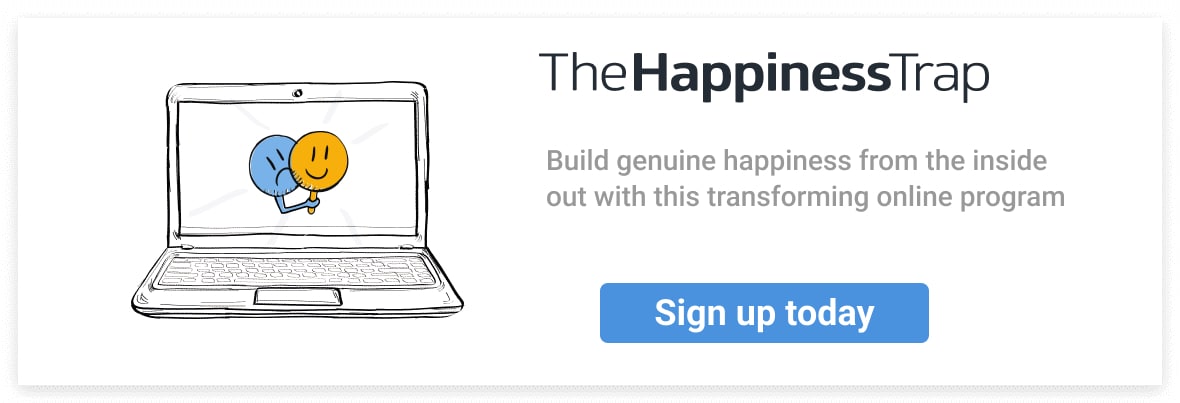
What’s in My Control and What’s Not
So here are some ideas to help you get clearer about what definitely is not in our control, and what isn’t, in our control, and what potentially is:
Outside My Control
- Vast majority of my emotions & feelings
- Vast majority of my thoughts
- Vast majority of my sensations
- My memories
- Whether or not I achieve my goals
- How good I feel when doing what I do
- What other people say and do
- How others perceive my motivations
- How others judge or perceive me
- What happens in the future
- What happened in the past
- Inevitable painful losses in life
- Whether or not life gives me what I want
- The inevitability of ageing, illness and injury
Within My Control (Potentially)
- How I respond to my emotions & feelings
- How I respond to my thoughts
- How I respond to my sensations
- How I respond to my memories
- How much action I take towards my goals
- How much I focus on & engage in what I do
- What I say and do to influence other people
- How much I use my values for motivation
- Whether or not I act like the sort of person I want to be
- What I say and do to influence the future
- How I respond to thoughts about the past
- Being self-compassionate when losses occur
- The values I live by, whether or not life gives me what I want
- How I take care of and look after myself
Note the very important word “potentially.”
If we’re on auto-pilot, being jerked around by our thoughts and feelings, we’re not likely to be able to exert control in these areas.
But if we are mindful – that is self-aware, present, engaged in what we are doing, able to let our thoughts and feelings flow through us without getting hooked by them – then we can exert control in these areas.
Of course, this isn’t an exhaustive list; I’m sure you can think of other things to add on both sides. However, it’s a good start. So if you want to empower yourself, then get mindful and focus on the stuff within your control.
Good luck!

A lot of us get stuck because we focus on things that are outside of our control. The more we do this, the more disempowered we are, and the more frustrated or disappointed or angry or anxious we feel.
In contrast, the more we focus on what’s in our control, the more empowered we are; we can actually do something useful.
So here are some ideas to help you get clearer about what definitely is not in our control, and what isn’t, in our control, and what potentially is:
Outside My Control
- Vast majority of my emotions & feelings
- Vast majority of my thoughts
- Vast majority of my sensations
- My memories
- Whether or not I achieve my goals
- How good I feel when doing what I do
- What other people say and do
- How others perceive my motivations
- How others judge or perceive me
- What happens in the future
- What happened in the past
- Inevitable painful losses in life
- Whether or not life gives me what I want
- The inevitability of ageing, illness and injury
Within My Control (Potentially)
- How I respond to my emotions & feelings
- How I respond to my thoughts
- How I respond to my sensations
- How I respond to my memories
- How much action I take towards my goals
- How much I focus on & engage in what I do
- What I say and do to influence other people
- How much I use my values for motivation
- Whether or not I act like the sort of person I want to be
- What I say and do to influence the future
- How I respond to thoughts about the past
- Being self-compassionate when losses occur
- The values I live by, whether or not life gives me what I want
- How I take care of and look after myself
Note the very important word “potentially.”
If we’re on auto-pilot, being jerked around by our thoughts and feelings, we’re not likely to be able to exert control in these areas.
But if we are mindful – that is self-aware, present, engaged in what we are doing, able to let our thoughts and feelings flow through us without getting hooked by them – then we can exert control in these areas.
Of course, this isn’t an exhaustive list; I’m sure you can think of other things to add on both sides. However, it’s a good start. So if you want to empower yourself, then get mindful and focus on the stuff within your control.
Good luck!

D) Routines
If you get up every morning at the same time to meditate or exercise or do yoga, over time that regular routine will become habitual.
In other words, you won’t have to think so hard about doing it; it will start to come naturally; it will require less ‘willpower’; it will become a part of your regular routine. So experiment: see if you can find some way to build a regular routine or ritual around your new behavior.
So it starts to become part of your way of life. For example, if you drive home from work, then every night, just before you get out of your car, you might do two minutes of mindful breathing, and reflect on what values you want to live by when you walk through the front door into your home.
E) Relationships
It’s easier to study if you have a ‘study-buddy’; easier to exercise if you have an ‘exercise-buddy’. In AA programs, they team you up with a sponsor who is there to help you stay sober when the going gets tough.
So can you find a kind, caring, encouraging person who can help support you with your new behavior? Maybe you can check in with this person on a regular basis, and tell them how well you are doing, as mentioned in Rewards.
Or maybe you can email your support person the Records you’ve been keeping. Or maybe you can use the other person as a Reminder; ask them to remind you to do the new behavior, if and when that would be useful. For example, you might say to your partner, ‘When you see me worrying, can you please remind me to do some mindful breathing?’
F) Reflecting
Regularly take time to reflect on how you are behaving, and what effect it is having on your life. You can do this via writing it down – Records – or in discussion with another person – Relationships.
Or you can do this as a mental exercise throughout the day, or just before you go to bed, or just as you’re waking up in the morning. You simply take a few moments to reflect on questions such as:
- “How am I going?”
- “What am I doing that’s working?”
- “What am I doing that’s not working?”
- “What can I do more of, or less of, or differently?”
Make sure you also reflect on the times that you STOP doing the new behaviour, and fall back into the old one. Notice what triggers those relapses and setbacks, and notice what it costs you – i.e. how do you suffer? – when that happens.
This doesn’t mean beat yourself up! This means non-judgmentally reflect on the genuine costs to your health and wellbeing of falling back into old habits – and use your awareness of the suffering this causes you to help motivate yourself to get back on track.
G) Restructuring
We can often restructure our environment to make our new behaviour easier, and therefore more likely to sustain.
For example, if the new behavior is ‘healthy eating’ we can restructure the kitchen to make that easier: get rid of or hide away the junk food, and stock the fridge and pantry with the healthy stuff.
If we want to go to the gym in the morning, we could pack up our sports-gear in our gym-bag, and place it by the side of the bed or somewhere else obvious and convenient, so it’s all ready to go as soon as we get up.
(And of course, when we see our gym kit lying there, it acts as a Reminder.)
So there you have it.
‘The seven Rs’: Reminders, Records, Rewards, Routines, Relationships, Reflection, and Restructuring.
Now be creative; mix and match these methods to your heart’s content, to create your own set of tools for lasting change.
Good luck with it!
It’s a lot easier to start some new type of life-enhancing behaviour than it is to keep it going. How can we sustain new patterns of behaviour, until we’ve done them for so long they become habitual?
And for those of us who are therapists, coaches, or other types of health professional: how can we help our clients to keep up new behaviour between sessions?
Well, there are hundreds, if not thousands of tools out there to help us with this challenge, but we can pretty much bundle them all into what I like to call ‘The Seven Rs’: Reminders, Records, Rewards, Routines, Relationships, Reflecting, and Restructuring. Let’s take a look at each.
A) Reminders
We can create all sorts of simple tools to help remind us of the new behavior we wish to persist with. For example, we might create a pop-up or a screen saver on our computer or mobile phone with an important word or phrase or symbol that reminds us to act mindfully or to utilize a particular value.
We might use the old favourite of writing a message on a card and sticking it on the fridge or propping it against the bathroom mirror or taping it to the car dashboard.
Or we might write something in a diary or calendar or in the ‘notes’ app of a smartphone. We might write just one word, like ‘Breathe’ or ‘Pause’ or ‘Patience’, or we might use an acronym like ‘A.C.T.’ or ‘S.T.O.P.’, or a phrase like ‘Letting go’ or ‘Caring and compassionate‘.
Alternatively we might put a brightly-coloured sticker on the strap of our wristwatch or the back of our smartphone or the keyboard of our computer, so that every time we use these devices, the sticker reminds us to do the new behaviour.
B) Records
We can keep a record of our behavior throughout the day, noting down when and where we do the new behavior, and what the benefits are; and also when and where we do the old behavior, and what the costs are. Any diary or notebook – on paper, or on a computer screen – can serve this purpose.
C) Rewards
When we do some form of new behavior that involves mindfully acting on our values, hopefully that will be rewarding in its own right. However, we can help to reinforce the new behavior with additional rewards.
One form of reward is kind, encouraging self-talk, e.g. saying to yourself: ‘Well done. You did it!’ Another form of reward is sharing your success and progress with a loved one who you know will respond positively.
On the other hand, you might prefer more material rewards. For example, if you sustain this new behavior for a whole week, you buy or do something that you really like, e.g. get a massage or buy a CD.
Why Do I Feel Like This?
We all have times when we don’t feel so good. And in those moments, many of us ask ourselves the perfectly reasonable question “Why do I feel like this?”
Now there’s a bright side to this question … and there’s also a dark side.
The Bright Side
The bright side of this question is that it can help to alert us to issues we need to deal with.
For example, suppose the answer is we’ve been fighting with our partner, eating too much junk, drinking too much, not getting enough sleep, working too hard, not exercising enough, smoking, taking drugs, partying too hard, worrying about our kids, coping with an illness, struggling financially, racing to meet a deadline, facing the death of a loved one.
If so, then recognising those issues as the trigger for our painful emotions is a useful first step. And the second step is then: take action! Do something practical, useful and helpful to effectively deal with or adapt better to the situation.
Now usually, such issues are obvious – and you can identify them easily and instantly when you ask yourself the above question. But suppose you find that there is no obvious answer for why you are feeling down or anxious or sad or grumpy; what happens if you keep on asking yourself the question?
Well, that’s where things go awry. If you keep asking yourself “Why do I feel this way?” when there’s no immediate obvious answer, it usually just hooks you into …
The Dark Side
The dark side of this question is what psychologists call “rumination”. We get lost in our thoughts, analysing all the possible reasons for “why I feel like this”.
Usually, we then start running through all the unpleasant things that have happened to us, all the things that are wrong with our life, all the things that aren’t good enough in ourselves or others or the world around us, wondering if any of them might be the cause.
Naturally this pulls us more and more into discontentment, dissatisfaction, as we run through everything that’s lacking in our life. (Hardly surprising that this pattern of thinking plays a big role in depression.)
So when you catch yourself caught up in this type of thinking, it’s a good idea to unhook from it:
- Notice the thinking process and silently name it: “Aha! Here’s my mind trying to figure it out again” or “Aha! There’s the ‘why do I feel like this?’ story” or “Here’s rumination” or simply “Analysing”.
- Use your mindfulness skills to unhook from theses thoughts and get fully present
- Start doing some meaningful, life-enhancing activity, and give it your full attention
- Engage in what you’re doing
- In this manner, repeatedly unhook yourself from the “Why do I feel this way?” story – over and over and over again; and repeatedly refocus on the activity you are doing.
But What Do I Do About The Feeling?
- Use your mindfulness skills to practice acceptance of the feeling, and be self-compassionate.
- Take action: do whatever you can to improve the situation or solve the problem that’s triggering it.
- And if there’s no effective action you can take, stick with A). But stop trying to analyse the feeling, and instead put your attention and energy into doing something meaningful.
Remember feelings change like the weather; and sooner or later this feeling, no matter how unpleasant, will pass.
The Happiness Trap Online Program
The Happiness Trap Online Program is based on an empirically-supported model known as Acceptance and Commitment Therapy (ACT).
Over a 35 year period, evidence has mounted for ACT’s effectiveness in treating conditions including anxiety, chronic pain, depression, stress, smoking, weight loss and performance enhancement.
The Happiness Trap program teaches highly-effective strategies and interventions based on the ACT model, which can help you stop struggling with difficult thoughts and feelings and build genuine and lasting happiness.
In a word: yes!
It’s not hard for most of us to get rid of unwanted thoughts & feelings … as long as they’re relatively mild.
When we’re a little bit anxious, a little bit angry, a little bit sad, it’s usually quite easy to ignore those difficult feelings, or distract ourselves from them, or think positively, or do a relaxation technique – and make ourselves feel better as a result.
But the more intense and painful our difficult thoughts & feelings, the harder it becomes to do this.
For example, if we’re mildly upset about something, and we eat some yummy food, chocolate or chips or ice-cream or whatever it is that tickles your taste buds, most of us will find that the tasty food successfully distracts us from our unpleasant feelings and makes us feel better.
But if we’re EXTREMELY upset about something, and we use this very same distraction strategy, we’re likely to fail; most of us will find we can barely taste that food in our mouth, that there’s little or no real pleasure in it, and it doesn’t help us escape those difficult feelings.
Likewise, if we’re a bit worried or anxious about something that’s not a major threat or a significant risk, then thinking logically and rationally about it, i.e.
- Carefully assessing the facts and calculating the real risks or
- Doing a simple relaxation technique, e.g. some slow breathing
will for most of us rapidly lower our anxiety, help us calm down, and enable us to stop worrying.
But if we’re EXTREMELY anxious about something that truly is a major threat or a very real and significant risk, these types of strategies just won’t work.
Example 1
For example, if you are going into hospital for major surgery for a life-threatening condition, how likely is it that a bit of positive thinking, relaxation, or distraction is going to get rid of your anxiety?
For sure, you may get a bit of short term relief from such methods, but how long would it last before the anxiety returns?
Example 2
For another example, consider: if someone you love very much were dying; could you stop yourself from feeling sad, angry or scared?
For most human beings, there are only two ways you could realistically do this.
- One way, would be to completely numb yourself with drugs or alcohol.
- The other way would be to completely cut off from your own emotions; this is technically called “dissociation”, and usually gives rise to an unpleasant sense of numbness, emptiness or hollowness.
The Take-Home Message
When our problems and challenges are minor, and our painful emotions are mild, it’s often quite easy to avoid, distract, escape from or get rid of unwanted thoughts and feelings.
But the bigger our challenges, and the more intense our emotions, the less our ability to do this.
And that’s why we can all benefit from making the effort to learn mindfulness, acceptance and self-compassion skills.
When we have these skills, we can respond more flexibly to our painful thoughts and feelings.
We can open up and make room for them. Instead of fighting against them, we can make peace with them.
We can let them flow through us without a struggle, allowing them to freely come and stay and go in their own good time.
Of course, such skills don’t come naturally or easily. It takes genuine effort to develop them.
But if we want to invest our precious time and energy in doing the sorts of things that make life meaningful, instead of wasting it in futile struggles with our feelings, then learning these skills is well worth the effort.
The Happiness Trap Online Program
The Happiness Trap Online Program is based on an empirically-supported model known as Acceptance and Commitment Therapy (ACT).
Over a 35 year period, evidence has mounted for ACT’s effectiveness in treating conditions including anxiety, chronic pain, depression, stress, smoking, weight loss and performance enhancement.
The Happiness Trap program teaches highly-effective strategies and interventions based on the ACT model, which can help you manage unhelpful thoughts and feelings and build genuine and lasting happiness.

Not-So-Happy Holidays?
We say ‘happy holidays’, but the truth is, for many of us the festive season is a less-than-perfect mixture of both delight and dread. I, for one, have had plenty of holiday misery over the years – from difficult divorces (first my parents, then later my own!) to deaths of loved ones to family feuds, and so on.
Let’s face it: when the holidays happen, there are many potential sources of stress and suffering. For some people it’s a time of great loneliness; for a whole host of reasons you may feel cut off, disconnected, or isolated from others.
For other people, it’s a time of grief – especially if a loved one is very sick or dying, or if it’s the first Christmas since they died. And for almost all of us there are the perennial stresses of buying gifts (what to get, how much to spend, will they like it or not?), challenging social events (difficult relatives, family arguments, drunken revellers), competing family demands (with whose family members, on which days, do you celebrate what?) or just grappling with the logistics of hosting a feast.
For most of us, there’s a pretty big gap between the ‘festive season’ that’s promoted in popular culture – happy, harmonious friends and families, enjoying a blissful gathering – and the one that we get to experience in real life. And this in itself easily leads to frustration and disappointment, on top of all those other forms of stress.
So, what can we do to make the most of the holiday season while handling the stress that inevitably goes with it? Well, to quote the author H.L. Mencken,
‘For every complex situation, there is an answer that is simple, clear and wrong’. Wise words, huh? So, I’m not going to even attempt a simple answer. There just isn’t one.
Instead, what I’m going to suggest is a simple practice; something that can help you cope when the going gets tough. What I have in mind is the practice of ‘compassion’ – which basically means, to acknowledge suffering and respond with kindness.
Throughout the holiday season, when life is hard, acknowledge it. Pause for a moment, and truly acknowledge your difficulties and disappointments, and all the unpleasant feelings that go with them. Acknowledge, openly and honestly that it’s painful.
And then respond to your pain with genuine warmth and kindness; treat yourself like you would treat someone you love, if they were in a similar situation. (For more on how to do this, read my previous blog, The No BS Guide To Self-Compassion
Of course, practicing self-compassion won’t magically make your holidays into ‘happy, happy, happy’! But it will help you to cope with the challenges better.
And at the same time, look for opportunities to be compassionate to others. After all, they too are likely to be struggling.
And if you can reach out to your loved ones during those difficult times, and be there for them in a kind and supportive way, one of the greatest gifts you can ever give. As the ancient philosopher Philo put it: ‘Be kind, for everyone you meet is fighting a hard battle.’
How To Harness Your Anxiety
Riding a Wild Stallion – Extract from The Confidence Gap by Dr. Russ Harris
You step on to the front porch of your farm house. You feel the warm caress of the morning sun.
You stretch your arms wide and breathe in the fresh spring air. Then something on the horizon catches your eye. A shape in the distance, moving very quickly.
You rub your eyes, not quite sure if you are dreaming. But no, it’s real. You dash back inside, grab your binoculars, dash back out.
Raise them to your eyes. And there it is: a magnificent beast, thundering across the plain, powerful muscles rippling beneath a coat of pure black hair.
But it’s not one of your own horses. It’s a wild stallion. And somehow it has found its way on to your property. So, what do you do?
Fear is like a wild stallion. If we know how to harness its energy, we can use it to our advantage.
But if we don’t know how to handle it, we’re in trouble. Imagine approaching a wild stallion without some good horse-wrangling skills: you’d get kicked, bitten or trampled, and waste a lot of time and energy for no useful outcome.
On the other hand, if you’re a skilled horse-whisperer, then you can approach that horse safely. And over time, if you treat it well, you can build a good relationship with it and eventually ride it.
Now, I have to admit I know absolutely nothing about handling horses. But I do know quite a lot about handling fear. So, I’m going to show you how to become a ‘fear-whisperer’.
The ABC of Fear-Whispering
There’s a simple ABC formula for fear whispering. When fear shows up, we: allow it, befriend it and channel it.
Allow It
Think of that wild stallion racing around. If you ever want to make use of its awesome strength, speed and stamina, you first have to allow it to stay on your ranch. And the same goes for fear.
There is a huge amount of energy within our fear. Remember, the fight-or-flight response evolved over hundreds of millions of years to prepare our bodies for action.
Fear gives us sharpened reflexes, increased muscle tone, heightened awareness and greater strength. It’s like a potent fuel. But we’ll never learn how to use that fuel if we’re not willing to handle it.
Once you learn how to ‘allow’ your fear: you notice, acknowledge and make room for it. After allowing, the next step is to…
Befriend It
If you want to tame that wild horse, allowing it to stay on your ranch is not enough. You have to build a positive relationship with it; you have to win its trust.
How do you do that? Well, from what I’ve seen in the movies, you approach it cautiously, and talk softly and gently, get closer and closer, and then offer it some tasty food, and if it lets you, stroke its flank, keep talking calmly and soothingly, and show it that you’re a friend, not a threat.
Note: we do have to be careful when comparing horses with fear, because horses can seriously injure or even kill you. In contrast, fear is totally harmless.
The worst it can do is make us feel very uncomfortable but that aside, the comparison is useful: if we want to use our fear to our advantage, allowing it isn’t enough; we need to befriend it.
Now, at this point your mind may start protesting, ‘But I don’t like this feeling!’ Rest assured: you don’t have to like it.
Let’s suppose there is a lonely old man in your neighborhood, and I offer to pay you ten billion dollars to befriend him.
And let’s suppose this man has some unusual habits; he is prone to angry outbursts of abusive comments, wears filthy clothes and totally neglects his personal hygiene.
So, you really don’t like him. And yet … there’s ten billion dollars at stake here. Would you make the effort to befriend him, even if you didn’t like him? For ten billion dollars, I’m sure you would!
So, what about fear? If befriending it helps you to live by your values, achieve your goals, perform at your peak, develop genuine confidence and generally live a richer, fuller, more meaningful life, then will you make the effort, even though you don’t like it?
Befriending our fear is just like befriending a person or a horse.
Friendliness involves being pleasant, welcoming, affectionate, trusting collaborative and helpful. Does this sound like a tall order? Maybe it is, but I encourage you to give it a try and see what happens.
Be pleasant and welcoming to your fear. It may seem very weird, but try talking to it (making sure to keep a strong sense of humour).
You might say, ‘Hello, fear. How thoughtful of you to drop by today. Come on in and make yourself at home. What do you want to do today? Oh, you want to give my heart a bit of a work-out, do you?
Please, do be my guest. See how fast you can get it racing. Oh, you want to chase some butterflies around my stomach? Please, go for it. My house is your house.’
Obviously, you wouldn’t do something like this in the middle of an interview or a performance, because it would interfere with task-focused attention.
But there are plenty of times and places where you could try this, such as in the car, in bed, waiting in queues, during commercial breaks on TV and so on.
Be affectionate towards your fear. If you’ve got a good imagination, you could imagine shaking fear’s hand, inviting it into your body, and slipping your arm warmly around its back.
And if you’re somewhere private, then you could gently place a hand on the fear – that is, on the part of the body where you feel it most intensely – and ‘hold it gently’; let it feel the soothing warmth of your hand.
Be trusting towards your fear. It’s not out to get you. Fear evolved for a purpose: to help us handle challenging situations effectively. It alerts us to risks and threats, and readies us for action, should it be necessary. So, we’d be in big trouble if we didn’t have any.
Be collaborative with your fear. Recognise you’re ‘playing on the same team’. Don’t fight with your fear; it’s there to support you. It’s a signal; it lets you know you’re facing a challenge. So perhaps you could remind yourself,
‘This is my brain, alerting me to a challenge; this is my body getting me ready for action.’
Regard it as a teammate, not an opponent.
Be helpful towards your fear. Fear evolved to give you strength, speed, focus and stamina. So, help it to do its job. Help it to put its energy into something useful, something meaningful, something life-enhancing. In other words . . .
Channel It
Cast your mind back once more to that wild stallion. You’ve allowed it to stay and befriended it. Now what? Now you want to use it to your benefit; to saddle it up and ride it.
And so, it is with fear. You’ve allowed it, befriended it – now use it. Take a moment to notice how much energy it gives you: all that adrenaline flowing through your system. Your whole body is geared up for action.
As I mentioned earlier, many successful athlete’s, business people and stage performers don’t use the word ‘fear’ to describe those feelings they have when facing a challenge.
They often talk instead of being ‘revved’, ‘pumped’, ‘juiced’, ‘wired’ or ‘amped’. These terms all acknowledge the energising aspects of the fight-or- flight response.
So, ask yourself,
‘How can I make use of all this energy? What values-guided activities can I channel it into?’
Of course, there are situations where you can’t channel your fear into something useful.
For example, if you’re out on a first date, chatting away in a quiet bar or restaurant, there’s not much you can do with all that energy. In such an instance, you just make room for it and engage fully in the present.
However, there are plenty of times when you can make good use of your energy. For example, if you’re playing sport, being physically active or giving some sort of performance, then you can channel all this ‘fear energy’ into it.
Reminding Yourself to Use Fear
Reminding yourself to use your fear can make a huge difference at times.
Over the past few years, I’ve been giving talks and workshops in Australia, the US and Europe, to audiences varying in size from half a dozen to several thousand.
Do I feel confident about doing this? Well, most of the time, yes, I do. I certainly didn’t feel confident when I first started, but now I’ve had so much practice that I generally do.
However, when I’m speaking on a new topic, or running a brand-new type of workshop, I definitely do not feel confident. (Nor do I expect to, until I’ve done it over and over.)
But I do act with confidence: I get up on stage, give the speech or workshop and engage fully in the task.
Now here’s the thing: regardless of whether or not I feel confident, I always feel fear.
If that surprises you, let me remind you of some basic human biology: when we’re facing a genuine challenge, we’re going to have a fight-or-flight response.
So, no matter how confident we are at doing something, if the situation is challenging, we’ll feel fear. You may recall this rule:
Genuine confidence is not the absence of fear; it is a transformed relationship with fear
Thus, before I start my talk or workshop, I make room for my fear, take a deep breath, and say to myself, ‘Okay! Here we go! Let’s put this energy into action!’
The fear is still there, but my relationship with it has transformed. Now it’s not just something I need to make room for in order to get on with my life.
Now it’s something useful in its own right. It’s a potent fuel; a burst of energy that revs me up, gets me buzzing and enhances my performance.
And you can do the same thing in your life. Remind yourself regularly to channel your fear and notice the difference it makes when you do so. It may take a while to get the hang of this, but when you do, it makes a huge difference.
Indeed, over time, you may find your-self using words like ‘revved’, ‘pumped’ and ‘amped’, instead of ‘fear’ and ‘anxiety’.
And if there’s nothing for you to channel your fear into, then make room for it and engage fully in whatever you are doing.
Don’t fight your fear; allow it, befriend it and channel it.

Living Your Values When Life Isn’t Great
We often find ourselves in situations that we don’t want to be in or having to do things we don’t particularly like.
But what happens if we take the time to get in touch with our values; to clarify what sort of person we want to be and how we want to treat ourselves and others?
Once we know our values, we can ‘sprinkle’ them into our actions; use them to ‘flavour’ whatever we are saying and doing. And almost always when we do this, whatever we’re doing then becomes far more rewarding.
For example, consider the case of Rob, a 22-year-old university student.
While Rob was studying a five-year architecture course, he was working part-time as a waiter to help pay his way. He told me that he hated his job, but he needed the money to pay for his food and board.
He knew it was only temporary and that in one more year he’d be working as an architect, but that didn’t stop him from dreading every shift.
It wasn’t that he worked in a horrible place or had some terrible boss; he just didn’t like the work. The only other part-time work he could get was cleaning, stocking shelves, serving hamburgers or bartending, and these were, in his opinion, even worse.
I questioned him about his values and how he could use them to transform his relationship with his job.
He identified values such as mindfulness, caring, curiosity, openness warmth and humour. I then asked him what might happen if he engaged mindfully with the customers?
What difference might it make if he were to be fully present? To pay attention with openness and curiosity to the clothes they wore, the style of their hair, and the tone and rhythm of their voices? To notice the way that they ate and drank and spoke?
To notice their facial expressions and physical gestures? And what might happen if he was more caring about the customers: if he cared about their experience in the restaurant and the quality of his service?
Inspired by this way of thinking, Rob had an idea. He would become a ‘Zen master of pizza delivery’. He would connect mindfully with his body to ensure he had the best possible posture and carry that pizza as if it were a priceless work of art.
He would be more caring about how he lowered that pizza to the table; he’d lay it down as if placing it in front of a king. All the while, he would contribute warmth and good grace and he’d also share his excellent sense of humour.
And the result? Well, his work didn’t magically turn into some ‘dream job’, but it did become much more fulfilling.
He wasn’t ‘just waiting pizzas’ anymore; now he was contributing to people’s lives, challenging his body, engaging in the world, developing his mindfulness skills and having moments of fun along the way.
He was staggered by the difference it made. The dread disappeared and so did the boredom. There was still a huge difference between the job he ideally wanted and the one he had, but he had discovered the fulfilment of living by his values.
What is Mindfulness?
When I first wrote The Happiness Trap – back in 2006 – I didn’t even mention the word ‘mindfulness’ until almost half way through the book, because back then almost nobody knew what it meant.
Well, times have changed. In the last decade, there’s been an explosion of interest in mindfulness, and the problem now is that many people think they know what it means, when actually they don’t!
For example, many people think it’s a type of meditation, or relaxation, or positive thinking, or a spiritual/religious practice, or it comes from Buddhism, and none of these ideas are accurate.
Yup, that’s right; not one of those ideas is correct, as you’ll see in the video I have linked to at the end of this blog. But before we get to that, let’s get clear about what mindfulness actually is.
We can think of mindfulness as a psychological toolkit for enhancing your health, wellbeing and life.
And there are many different tools within this kit – which serve a variety of different purposes.
There are tools which help you focus, and refocus, your attention on the task or activity you are doing, and engage in it fully (focusing & engaging skills); others that help you to detach or unhook from difficult or unhelpful thoughts (unhooking or defusion skills); others that help you open up and make room for painful emotions, and allow them to flow through you (acceptance or expansion skills); and yet others that enable you to savour, appreciate and enhance the satisfaction of enjoyable and pleasurable experiences (savouring skills).
And all these different skills have one common factor: they all involve paying attention in a particular way, with an attitude of openness, curiosity, and flexibility.
“Flexibility” means we can direct our attention to wherever it will be most useful. This might be our inner world of thoughts and feelings, or the outer world that we know through the five senses, and it may involve narrowing our focus, or broadening our focus, or shifting it altogether.
And no matter what we focus on – our thoughts and feelings, our words and actions, the world around us, our aim is to do so with openness to and curiosity about the object(s) of our attention.
So we can define mindfulness as: ‘A set of psychological skills for enhancing life, that involve paying attention with openness, curiosity and flexibility.’
In later blogs, I’ll explore some of the many different skills in the mindfulness toolkit. For now, though, I want to end this blog with a link to a short video about the 5 most common myths about mindfulness. I hope you enjoy it.
The No BS Guide To Self-Compassion
Imagine you’re going through a rough patch, one of the toughest ordeals you’ve ever had to cope with in life. You’re facing all sorts of challenges, obstacles, difficulties. It’s painful and stressful, and there’s no quick fix or easy solution. Now, as you go through this, what kind of companion would you like by your side?
The kind of companion who says, with a cold, uncaring voice, “Suck it up, princess. I don’t want to hear your whingeing and whining. What have you got to complain about? There are starving kids in Africa, this is trivial.
What’s wrong with you? Why are you so weak? Just shut up and get on with it.”? Or the kind of companion who says, with a kind and caring voice, “This is really tough. And I want you to know, I’ve got your back. I’m going to help you get through this. I’m with you every step of the way.”?
It’s a no-brainer, right? All of us – even super tough men and women who work in the armed forces and emergency services – would choose the second companion over the first. What this second companion demonstrates is a quality called “compassion” – which means ‘acknowledging the suffering of others and responding with kindness and caring’.
Sadly, the truth is, most of us are a lot better at being compassionate to others, than we are to ourselves. When we are in pain, we often treat ourselves a lot more like the first companion than the second. Self-compassion means learning to treat ourselves like the second companion: acknowledging our own suffering and responding to ourselves with kindness and caring.
In other words, self-compassion means treating ourselves with the same warmth, caring and kindness that we’d extend to someone we love or deeply care about, if they were in similar pain.
For thousands of years, self-compassion has played a central role in many religious and spiritual practices, and now it is becoming increasingly important in many science-based models of therapy, coaching and counselling.
Certainly, it is implicit in every aspect of the evidence-based Acceptance & Commitment Therapy model, upon which The Happiness Trap Online Program is based.
A wealth of research shows the many benefits of self-compassion with everything from depression and anxiety disorders to grief, trauma and addiction, to dealing with stress and pressure in the workplace.
Self-compassion helps you to cope better with stress, anxiety and pressure, to bounce back from failures and setbacks, to cope better with grief and loss, and to handle any type of emotional or physical pain more effectively.
So it’s well worth knowing how to develop it in yourself. And if you’re worried that it’s going to involve meditation or a religious practice of some sort, rest assured: it doesn’t.
Although there are all sorts of mediative and religious practices that can be used to develop self-compassion, there are also many other ways that are arguably a lot simpler.
There are two basic steps to self-compassion:
- Acknowledge your own suffering.
- Respond to yourself with kindness and caring.
The easiest place to begin is with a simple thought experiment. If you wanted to be compassionate to someone you love, who comes to you in great pain, tells you how much they are suffering – what are some kind words you might say to them?
What are some kind things you might do for them? Whatever your answers are to those questions, apply them to yourself. Try saying the same kind words to yourself, and doing the same kind things for yourself, that you’d do for someone you love.
Of course, there’s much more to self-compassion than this, and I’ll be exploring other aspects in future blogs. But this is a good place to start. So next time you’re suffering, acknowledge it, and respond with kindness. This doesn’t come naturally to most of us – but it’s a skill that’s well worth making the effort to develop.
Dealing with Dilemmas
If there’s one thing that sucks the joy out of life, it’s going through your day trying to resolve some difficult dilemma. We’ve all, at times, had to grapple with really hard decisions and tough choices.
‘Do I stay in this relationship – or leave?’,
‘Do I quit this job – or do I stay?’,
‘Do I enrol in that course – or the other one?’,
‘Do I have the operation – or not?’,
‘Do we try to have children – or not?’, ‘
Do I buy this one – or the other one?’, ‘
Do I want to live here – or there?’
When we’re dealing with these dilemmas, our mind easily goes into overdrive, desperately trying to figure out what to do; to ‘make the right decision’.
The problem is, it can take days, weeks, months – or even years in some cases, such as unhappy marriages or unfulfilling jobs – before we finally choose one option over the other.
And, in the meantime, we can easily spend our days wandering around in a thick psychological smog – endlessly pondering: ‘Do I or don’t I?’ – and, in the process, we make ourselves anxious or stressed, and we miss out on life, here and now.
So, how can ACT help us?
Step 1: Acceptance
When my clients present their dilemmas, hard decisions or tough choices I start off by telling them,
‘You probably will not make your final decision during our session today. It could happen – but it’s extremely unlikely.’
And if you are facing a major dilemma or decision in your life today, this is almost certainly true for you; you are not likely to resolve it in the next 24 hours. Can you make room for this reality? Struggling with it will only make it worse.
Step 2: Common Sense Steps: Costs & Benefits & More Information
Sometimes a dilemma can be resolved by the age-old common-sense method of a ‘cost-benefit analysis’. In other words, write down a list of all the benefits and all the costs for each option.
If you’ve already done this and it hasn’t helped, fair enough – at least you tried. But if you haven’t done this – or if you’ve done it half-heartedly – or you’ve done it in your head but not on paper – then you should definitely give it a go.
When you write it all down in black and white, that is a very different experience than thinking it through inside you head or talking it through with a friend – and it may help you finalise your decision.
Keep in mind that sometimes the issue can be resolved by finding out more information from a reliable source (a book, a person, a website, an organization, etc.) So make sure you have gathered enough information to make an informed decision.
If you are lucky, this new information will make the costs and benefits of each option clearer, and help you decide what to do.
However, the inconvenient truth is this: the greater the dilemma, the tougher the decision, the less likely these ‘common sense’ methods are to be helpful. Why? Because if one option was obviously far better than the other, then you wouldn’t have a dilemma in the first place!
Step 3: No Perfect Solution
Next, recognise there is no perfect solution, so whichever choice you make, you are likely to feel anxious about it – and your mind is likely to tell you,
‘That’s the wrong decision’, then point out all the reasons why you shouldn’t do it.
If you’re waiting until the day there’s no feelings of anxiety, and no thoughts about making the wrong decision, you’ll probably be waiting forever.
Step 4: There’s No Way Not To Choose
Recognise that whatever your dilemma is, you’re already making a choice. Each day you don’t quit your job, you are choosing to stay (until the day you hand in your resignation, you are staying in that job.)
Each day that you don’t leave your marriage, you are choosing to stay (until the day you pack your bags and move out of the house, you are staying in that marriage.)
Each day that you don’t sign the consent form for the operation, you are choosing not to have surgery, and so on.
Step 5: Acknowledge Today’s Choice
Following on from the above, kick off each day by acknowledging the choice you are making for this day.
For example, say to yourself,
‘Okay, for the next 24 hours, I choose to stay in the marriage’ or ‘For the next 24 hours, I choose to keep using contraceptives.’
If 24 hours seems too long, then make a choice for the next 12 hours, or 6 hours, or even for the next sixty minutes.
At the end of that time period, reassess and make another choice – for the next 24 or 12 or 6 hours (or even sixty minutes).
Step 6: Take A Stand
Given your choice in step 5 above, what do you want to stand for in the next 24, 12 or 6 hours (or even sixty minutes)?
What values do you want to live by, in this area of life? If you’re staying in the marriage for another day or another hour, what sort of partner do you want to be for that one day or hour?
If you’re staying in your job for another day or another hour, what sort of employee do you want to be for that one day or hour?
Step 7: Make Time To Reflect
Put aside time on a regular basis to mindfully reflect on the situation. The best way to do this is as in step 2: using a diary or a computer, write down the costs and benefits of each option, and see if anything has changed since last time you did this.
You could also try to imagine what life might be like – both the positives and the negatives –
a) if you went down one path, and
b) if you went down the other path.
For most people, ten to fifteen minutes 3 or 4 times a week is more than enough reflection time – but you can put aside as little or as much as you like.
The key thing is, make it focused, in other words, don’t try to do it at the same time as watching TV or doing housework or driving home or going to the gym or cooking dinner. Just sit quietly with your pen and paper or a computer, and do nothing else but reflect, as above, for the allotted time.
Step 8: Name The Story
Throughout the day, your mind will try to pull you back into the dilemma, over and over again. But if this was truly helpful, you’d already have resolved your dilemma, wouldn’t you?
So practice ‘naming the story’. For example, try saying to yourself, ‘Aha! Here it is again. The “stay or leave” story.
Thanks mind. I know you’re trying to help, and it’s okay – I’ve got this covered.’
Then focus your attention on doing some meaningful, values-guided activity. You will probably find it helpful to remind yourself, ‘I’ll think about this later, in my scheduled reflection time’.
Step 9: Open Up & Make Room
Feelings of anxiety will almost certainly arise – again and again and again – whichever option you choose. So practice opening up & making room for those feelings.
Acknowledge to yourself, ‘Here’s anxiety.’ Remind yourself, ‘This is normal.
It’s what everybody feels in a challenging situation with an uncertain outcome.’
Step 10: Self-compassion
Last, but not least, be compassionate to yourself. Treat yourself gently. Talk to yourself kindly. Unhook yourself from all that unhelpful, self-judgmental mind-chatter, using whatever defusion techniques you find best – e.g. thanking your mind, naming the story etc.
Remind yourself that you’re a fallible human being, not some high-tech computer that can coldly analyse the probabilities and spit out an answer.
Remind yourself that this is a very difficult decision – if it were easy, you wouldn’t have a dilemma in the first place! Acknowledge that you’re in pain, you’re hurting.
And do plenty of kind, caring, nurturing, considerate things for yourself; things that soothe, or nurture, or support you in this time of hardship.
This could include anything from spending quality time with close friends, taking care of your body, treating yourself to a favourite leisure activity, making time for yourself to pursue a sport or creative outlet, or even cooking a healthy dinner. It’s often helpful to practice some form of self-compassion practice.
Recycle through these steps every day, or several times a day. And one of three things will happen:
1) Over time, one option becomes obviously more attractive than the other.
2) Over time, one option disappears, it’s no longer available.
3) Over time, your dilemma remains unsolved.
If either 1 or 2 happens, the decision is made, there is no dilemma any more.
If 3 happens, then at least you get to go through each day mindfully living by your values, instead of being lost in a smog of anxious indecision.
Plus, you’ll get plenty of practice at developing self-compassion.
Creating Lasting Change – 7 Awesome Tips
It’s a lot easier to start some new type of life-enhancing behaviour than it is to keep it going.
How can we sustain new patterns of behaviour, until we’ve done them for so long they become habitual?
And for those of us who are therapists, coaches, or other types of health professionals: how can we help our clients to keep up new behaviour between sessions?
Well, there are hundreds, if not thousands of tools out there to help us with this challenge, but we can pretty much bundle them all into what I like to call ‘The Seven Rs’: Reminders, Records, Rewards, Routines, Relationships, Reflecting, and Restructuring.
Now let’s take a look at each one individually.
1) Reminders
We can create all sorts of simple tools to help remind us of the new behaviour we wish to persist with.
For example, we might create a pop-up or a screen saver on our computer or mobile phone with an important word or phrase or symbol that reminds us to act mindfully or to utilise a particular value.
We might use the old favourite of writing a message on a post-it and sticking it on the fridge or propping it against the bathroom mirror or taping it to the car dashboard. Or we might write something in a diary or calendar or in the ‘notes’ app of a smartphone.
We might write just one word, like ‘breathe’ or ‘pause’ or ‘patience’, or we might use an acronym like ‘A.C.T’ or ‘S.T.O.P’, or a phrase like ‘letting go’ or ‘caring and compassionate’.
Alternatively we might put a brightly-coloured sticker on the strap of our wristwatch or the back of our smartphone or the keyboard of our computer, so that every time we use these devices, the sticker reminds us to do the new behaviour.
2) Records
We can keep a record of our behaviour throughout the day, noting down when and where we do the new behaviour, what the benefits are, when and where we do the old behaviour, and what the costs are.
Any diary or notebook – on paper, or on a computer screen – can serve this purpose.
3) Rewards
When we do some form of new behaviour that involves mindfully acting on our values, hopefully that will be rewarding in its own right. However, we can help to reinforce the new behaviour with additional rewards.
One form of reward is kind, encouraging self-talk, e.g. saying to yourself: ‘Well done. You did it!’ Another form of reward is sharing your success and progress with a loved one who you know will respond positively.
On the other hand, you might prefer more material rewards. For example, if you sustain this new behaviour for a whole week, you buy or do something that you really like – get a massage, for example.
4) Routines
If you get up every morning at the same time to meditate or exercise or do yoga, over time that regular routine will become habitual.
It will require less ‘willpower’ and it will become a part of your regular routine. So experiment: see if you can find some way to build a regular routine or ritual around your new behaviour, so it starts to become part of your way of life.
For example, if you drive home from work, then every night, just before you get out of your car, you might do two minutes of mindful breathing, and reflect on what values you want to live by when you walk through the front door into your home.
5) Relationships
It’s easier to study if you have a ‘study-buddy’, it’s easier to exercise if you have an ‘exercise-buddy’.
In AA programs, they team you up with a sponsor who is there to help you stay sober when the going gets tough. So can you find a kind, caring, encouraging person who can help support you with your new behaviour?
Maybe you can check in with this person on a regular basis and tell them how well you are doing, as mentioned in ‘Rewards’. Or maybe you can email your support person the ‘Records’ you’ve been keeping.
Or maybe you can use the other person as a ‘Reminder’ – ask them to remind you to do the new behaviour, if and when that would be useful. For example, you might say to your partner,
“When you see me worrying, can you please remind me to do some mindful breathing?”
6) Reflecting
Regularly take time to reflect on how you are behaving, and what effect it is having on your life. You can do this via writing it down – ‘Records’ – or in discussion with another person – ‘Relationships’.
Or you can do this as a mental exercise throughout the day, or just before you go to bed, or just as you’re waking up in the morning.
You simply take a few moments to reflect on questions such as:
1) How am I going?
2) What am I doing that’s working?
3) What am I doing that’s not working?
4) What can I do more of, or less of, or differently?
Make sure you also reflect on the times that you STOP doing the new behaviour, and fall back into the old one.
Notice what triggers those relapses and setbacks, and notice what it costs you – i.e. how do you suffer when that happens?
This doesn’t mean beat yourself up! This means non-judgmentally reflecting on the genuine costs to your health and wellbeing caused by falling back into old habits.
Then use your awareness of the suffering this causes you, to help motivate yourself to get back on track.
7) Restructuring
We can often restructure our environment to make our new behaviour easier, and therefore more sustainable.
For example, if the new behaviour is ‘healthy eating’ we can restructure the kitchen to make healthy eating easier.
We can get rid of, or hide away, the junk food, and stock the fridge and pantry with healthy stuff.
If we want to go to the gym in the morning, we could pack up our sports-gear in our gym-bag, and place it by the side of the bed or somewhere else obvious and convenient, so it’s all ready to go as soon as we get up.
So there you have it – ‘The Seven Rs’: Reminders, Records, Rewards, Routines, Relationships, Reflection, and Restructuring.
Now be creative! Mix and match these methods to your heart’s content to create your own set of tools for lasting change. Good luck with it!


Why Social Anxiety is Worse for Some Than Others
All of us, at times, get anxious in social situations. To understand the reasons behind this, check out my blog: The Biggest Myth About Social Anxiety.
Some of us are much more affected by social anxiety than others. Some people take social anxiety in their stride, it doesn’t hold them back from being who they want to be or doing what they want to do.
They can feel anxious but still go along to that party or meeting or conference or event – and once they’re there, they can still be themselves and engage fully in the social interaction.
However, others are severely affected by their anxiety, to such an extent it severely impacts their behaviour and restricts their life. They may avoid socialising, or drink heavily to get themselves through it, or arrive late and leave early and hover in the background saying next to nothing, or do numerous other self-defeating behaviours.
Indeed, around 12% of the population are so negatively impacted by social anxiety, they meet criteria for a clinical diagnosis of “social anxiety disorder”.
As we saw in last week’s blog, social anxiety is normal, so why does it affect some people so severely?
Good question. Prepare yourself because there is a big psychological jargon word coming up soon. It’s due to something called…
Experiential Avoidance
‘Experiential avoidance’ means the ongoing attempt to avoid or get rid of unwanted thoughts and feelings. And it’s normal! We are all ‘experientially avoidant’.
I’ve never met a human being who said, “I just luuuurve having painful thoughts and feelings, please give me more!”. We all like to avoid uncomfortable inner experiences such as painful thoughts, feelings, emotions, memories, etc.
And we all have a zillion-and-one ways of getting rid of them or distracting ourselves from them – from drugs, alcohol and cigarettes to exercise, music, and Game of Thrones.
Now, a little bit of experiential avoidance is not a problem. But high levels of experiential avoidance is a massive problem.
The more effort, time and energy we expend on trying to avoid or get rid of unpleasant thoughts and feelings, the greater our risk of developing an anxiety disorder, an addiction, clinical depression, and a whole host of other psychological problems. In other words, what creates an “anxiety disorder” is not “anxiety” itself.
Anxiety is a normal human emotion that we all repeatedly have throughout our lives. There’s no such thing as an anxiety-free life, we experience it every time we approach or enter into a challenging situation with an uncertain outcome.
What creates an “anxiety disorder” is high levels of experiential avoidance: investing large amounts of our time and energy into trying to avoid or get rid of anxiety.
“What???” I hear you say, “That just makes no sense! How can that be? Verily, thou dost baffle and bewilder me with thine strange and contentious manner of speaking.
Explain thyself, before I doth flatten you with my trusty war hammer.” That’s a fairly normal reaction (especially if you’ve been watching movies featuring Thor the Thunder God). So let me explain. If you’re absolutely determined to avoid or get rid of that anxiety that shows up in some social situations, then what are your options?
One obvious option is to avoid those situations. We all do this at times, and in moderation, it’s not a problem. But done excessively, it leads to social isolation.
Another option is to damp down or distract yourself from the unwanted feelings by putting substances into your body – be it alcohol, drugs, cigarettes, medication, food or chocolate. Most of us have done this at times, and in moderation, it’s rarely a problem.
But if you do it excessively, over time it will likely have health costs, and maybe even lead to addiction.
A third option is to hide out in the background – to arrive late, leave early, and while you’re there, say very little (so you won’t say anything dumb) and reveal very little of what you truly think (so you won’t be judged).
This strategy usually leads to deep sense of dissatisfaction and it’s the very opposite of a rich and fulfilling social interaction. I could go on, but hopefully the point is already clear. High levels of experiential avoidance leads to the excessive use of strategies such as those above. And the excessive use of such strategies has two major costs:
- It makes your life worse in the long term.
- It actually increases the frequency and intensity of the anxious feelings you are trying to avoid
Spot the vicious cycle!
So with this in mind, I vote we get rid of the term “anxiety disorders” and start calling them “experiential avoidance disorders” instead. “But you don’t get it,” I hear you say (I have excellent hearing), “My anxiety is horrible, awful, unbearable – that’s why I try so hard to get rid of it.” Good point.
And the higher your level of experiential avoidance – the more determined you are to avoid anxiety – the more horrible, awful and unbearable your anxiety will become. So if you ever want to reach a point where your anxiety is not awful, horrible and unbearable, you’re going to need to learn a new way of dealing with it, a way of responding to it which is radically different to experiential avoidance.
Interested? Oh good, because that’s what we’ll look at over the next few blogs.
The Biggest Myth About Social Anxiety
Uh-oh! There’s a social event looming. Perhaps it’s a night out with friends, or a wedding, or a family reunion. Or maybe it’s a committee meeting, or an office party; a book club meeting, a networking event, a conference, a business meeting.
Whatever it is, you don’t want to go. Your mind is whirring: Will I enjoy it? Will I know anyone there? Will I say something foolish? Will they like me? Will they think I’m boring? Will I have a bad time?
Maybe you’ve got a knot in your stomach, or sweaty hands, or a racing heart. You’d like to pull out, to make an excuse, to postpone… Oh, what a relief it would be if the event got cancelled!
Ever felt a bit like this? I know I have, many, many, many times in my life. This is an example of what psychologists like to call “social anxiety”. Basically, the term means anxiety or fear related to social interaction with others. And it’s normal. Yup, you heard me right. Social anxiety is NORMAL.
Almost everyone feels anxious in at least some social situations. Yes, even that friend of yours who is always the “life’s blood” of the party, and all those social butterflies and masterful story-tellers and outrageous extroverts who always seem to have something interesting or funny or clever to say. Even they experience social anxiety in some situations.
So why is social anxiety so prevalent? I’m glad you asked. To answer this question, let’s go back in time, right the way back to the stone age (or if you like big words, the “Neolithic era”). You’re a cavewoman or a caveman and the world is a dangerous place.
You’re surrounded by wolves and bears and sabre-toothed tigers. Lots of mean critters outside your cave, only too eager to gobble up a puny two-legged naked ape for lunch.
If you want to survive in this world, you have to belong to a group. If the group kicks you out, you won’t live long by yourself. The wolves will have you for breakfast. And if you survive breakfast, the bears will have you for lunch. You won’t make it to dinner time.
So how does your mind ensure you fit in with the group? It compares you to all the other group members. It asks: Am I measuring up? Am I fitting in? Am I doing the right thing? Am I following the rules? Am I contributing enough? Do they like me? Am I doing anything that might get me rejected?
Does this sound a bit like your mind, at times? If so, join the club. We all have minds that sound a bit like this! We inherited them from our stone age ancestors.
And as a result we are constantly comparing ourselves to other members of the group, and assessing whether we are likely to be rejected.
We’re not consciously aware of it a lot of the time, but it’s continually happening – even in our sleep at times. (Ever had one of those dreams when you’re naked in public and everyone is staring at you? No? Oh – err – maybe that’s just me then!)
The number one myth about social anxiety is that it’s abnormal: everyone else out there just loves social interaction, and there’s something wrong with me for feeling anxious about it. And when we buy into this myth, we can easily beat ourselves up:
“What’s wrong with me?”, “Why am I like this?”, “I shouldn’t feel anxious”, “I’m being silly”, “I’m defective” etc.
And of course, this self-flagellation (I feel smart when I use big words like that) doesn’t help; we’re just piling harsh self-criticism on top of our social anxiety – which is likely to make it even worse!
Of course, some people’s lives are much more affected by social anxiety than others. Research shows around 50% of the population find that social anxiety has a significant negative impact on their life, and around 12% of the population are so badly affected by it, they meet criteria for a diagnosis of “social anxiety disorder”.
So in my next blog, we’ll look at why social anxiety affects some people so much more than others, and what makes it worse, and what makes it better. But for now, I want to leave you with one practical tip to help you deal with it. (There are many more practical tips to follow in my next few blogs on this topic; I just want you to experiment with this one for now).
Tip #1 for Social Anxiety: Acknowledge it’s normal
When you’re feeling social anxiety, take a moment to acknowledge it. With a kind inner voice, tell yourself: “This is normal, everyone feels this at times.”
This won’t get rid of your anxiety, of course; but it’s a whole lot better than beating yourself up for having a perfectly normal and commonplace human experience.
Being Right – Part 2
In part 1 we explored some of the problems with our very natural tendency to want to ‘be right’. Let’s now have a look at what we can do about this.
If we want to change any self-defeating behaviour, a great first step is to increase self-awareness. We want to notice when and where we are clinging to ‘I’m right’, and notice what effects that has on our behaviour – usually it leads us to speak in ways that are unkind, harsh, judgmental, critical, arrogant, egotistical, or aggressive.
And we also need to notice what effects it has on our relationships. Not surprisingly, it almost always makes them worse because no one likes to be spoken to in such a manner. And we need to keep in the back of our mind this question: ‘Would I prefer to be right or to be kind?’
If we wish to build healthy relationships with other people, where they feel cared for, respected, and well-treated, then the answer is obvious.
Being kind trumps being right. Even if we are right, and the other person is wrong, it is rarely helpful to point it out. And on those rare occasions where it is useful to point it out, it is so much better to do so with kindness, caring and respect, than with arrogance, condescension, or righteousness. After all, when you screw up or do something wrong, how would you prefer to be spoken to?
So, how can you tell if you’re too caught up in ‘being right’? Well, indicators may include: A lot of judging and criticising others, feeling superior or looking down on others, intolerance, condescension, smugness, refusing to back down, apologise, or admit that you made a mistake, continuing arguments on and on, long after they have become pointless, justifying your position continually (either to others or inside your own head), or loved ones saying things to you like, “Okay. You’re right and I’m wrong, yet again!”
So, if you think this issue applies to you (and I suspect it applies to some extent to almost everyone – it’s certainly something I struggle with!) then as soon as you realise you’ve been hooked by the ‘I’m right’ story – pause.
Pause and take a long breath. Then silently label what is happening inside your head: “Aha! Here I am trying to be right!” or “Aha! Here’s the ‘I’m right’ story again.” Or more simply just label it, ‘Being Right’.
Then pause a bit more and remember the question: ‘Would I prefer to be right or be kind?’ And finally, go to that kind place in our hearts and find a way to speak with warmth, kindness and respect, instead of righteousness.
Then notice what happens over time. You’re sure to see your relationships improve – and surely that’s better than being right. Right?
Being Right – Part 1
“There are two cardinal sins: Looking good and being right”.
I love this quote from my mentor, Steve Hayes. In a later blog we’ll cover ‘looking good’ but for now, we’re going to focus on ‘being right’.
‘What’s the problem with being right?’ you might be wondering. Good question. And the answer is… it depends.
It depends on the situation. In many situations, being right is not a problem at all. For example, if a doctor is right in his diagnosis and treatment of your illness, that’s great! But in other situations, being right can be very destructive.
For example, consider what happens in our relationships with loved ones when we are convinced that we are right.
If I insist that, ‘I’m right’, and then by default, ‘you are wrong!’ And how does it feel to be wrong? Not good.
When we believe we are ‘in the wrong’, we may feel guilty, sorry, ashamed, anxious, regretful, dumb, stupid, inadequate, incompetent, and so on.
And how does it feel to be right? We feel powerful, strong, righteous, correct. We feel totally justified, infallible, superior. Much better than being wrong.
‘I’m right, you’re wrong’ takes many different forms. It might be, ‘Here, give it to me. You don’t know how to do it!’ or ‘See! Look what happened! I told you!’ or ‘You know you’re not very good at this. Let me handle it.’ Or ‘I’m driving!’ or ‘Wrong!’ or ‘You’ve done it again!’ or ‘No!!!’ or ‘Why do you always do that?’ or ‘Why do you never listen to me?’ or even, ‘See? I was right!’
There are at least eleven thousand, two hundred and sixty three different ways of communicating, ‘I’m right, you’re wrong’ from rolling eyeballs to frowning to tut-ting to numerous variations on the phrases above.
And if we’re honest with ourselves, we do quite like to be right. Why? Because it makes us feel strong, smart, powerful, superior, or something similar. But unfortunately, it makes the other person feel weak, dumb powerless, inferior or something equally unpleasant. And that is not good for our relationships.
So what can we do about it? We’ll cover that in part 2.
No Worries? Really?
I run workshops around the world, and in every country I visit they have some version of the phrase ‘no worries’.
In my homeland, Australia, ‘no worries’ is virtually a national catchphrase. It’s incredibly rare to have a conversation without someone saying it.
In other countries, rather than ‘no worries’, it’s ‘no problem’ or ‘pas de probéme’ or ‘nema problema’. In India, I was amused by many taxi drivers who said to me, in their best English, “no worry, don’t hurry, chicken curry”. But if only the sentiment were true – if only we really didn’t have any worries or problems or stresses.
But of course, this isn’t the case. In Western countries, around 20% of the population will suffer from some type of anxiety disorder in their lifetime.
Yes, that is 1 in 5 people! And of course, even if we don’t suffer from a full-fledged anxiety disorder, we all know what it’s like to worry.
To go over and over our problems, imagining the worst, thinking about all the things that could possibly go wrong. I’ve asked over 30,000 people (in workshops and talks that I have given) to raise their hand if they are ever awake in the early hours of the morning worrying. Typically, about 90% of the hands in the audience go up.
To paraphrase Mark Twain, I’ve lived through thousands of frightening experiences in my life…and one or two of them did actually happen.
So isn’t it time we got a bit more honest about this? Isn’t it time to own up to our worrying? To stop denying it? I wonder what might happen if we started to see worrying as normal – as part of being human, rather than something to hide or deny or pretend doesn’t exist?
When we judge worrying as abnormal, unnatural, and the enemy of happiness (‘don’t worry, be happy!”) what happens? Inevitably, we get anxious about our worrying, and then in turn, we worry about our anxiety. And then as a knock-on, we worry about worrying about our anxiety.
Moreover, most of us are quick to say, “You worry too much’ or “I worry too much” or “I know I shouldn’t worry about it, but….?”
And many of us are also pretty quick to give what is arguably the most useless advice in the world: “Don’t worry about it!” (As if that is somehow magically going to stop the worrying!”
When my son was eight, the headmistress of his school proudly announced in the newsletter that the Grade 2 kids (aged 7 to 8) would adopt ‘Hakuna Matata’ as their catchphrase for the year. If you’ve ever seen the movie, “The Lion King”, you’ll recognize the phrase from the song of the same name. ‘Hakuna Matata’ means, “have no worries!”.
So I wrote her a long letter (poor woman). I talked about the grave dangers of sending this message to young kids. It denies their reality (all kids worry). And it makes them think worrying is abnormal! Or unnatural!
Which in turn will probably make them think there is something wrong with them. Wouldn’t it be better, I asked, if we taught them that everyone worries at times? That worrying is normal?
And then I suggested, given that there is no known way to stop the human mind from generating ‘worries’ (i.e., thoughts about unpleasant things that might happen in the future), we could teach them practical skills – mindfulness skills – to handle worrying more effectively.
Her reaction?
Well, let’s just say she didn’t appreciate my perspective. So all the kids got the “no worries” programming, including mine. But at least I was able to counteract it by teaching him the very opposite of what he was learning at school.
A sad reflection of the times we live in. But hey, no worries, right?
Rebuilding Trust
If we have been badly hurt, threatened, betrayed, cheated, deceived or abused by others, often we find it hard to trust again.
This especially likely if the people that did this to us were close friends or family members, or someone in a high trust position, such as a doctor or police officer. But if we go through life never trusting anyone again, that makes it hard, if not impossible, to build deep and meaningful relationships with others.
So when building relationships with new people, it’s useful to distinguish two very different kinds of trust: “blind trust” and “mindful trust”. “Blind trust” means trusting someone completely without taking the time to assess whether they are deserving of our trust. “Mindful trust” on the other hand, means wisely taking the time to assess the character of the person we are dealing with, before placing our trust in him or her.
Mindful trust involves paying curious attention to how honest, open and truthful this person is. In my experience, there are 4 qualities to look for when mindfully assessing how trustworthy someone is: sincerity, reliability, responsibility, competence, and respect.
- Sincerity: How sincere is this person? Does he truly mean what he says?
- Reliability: How reliable is this person? Does she follow through on the things she says she will do?
- Responsibility: How responsible is he? Does he consider the consequences of his actions? Does he own up to it, and apologise or make amends when he does something wrong?
- Competence: How competent is she? Is she actually competent to do the things she says she’s going to do?
As we get to know someone, we are able to directly assess whether they are sincere, reliable, responsible, and competent, based on our direct observation of their actions.
Armed with this knowledge, we can then establish mindful trust, or withhold our trust if we deem the other person unworthy of it. “Blind trust” is risky; but total distrust of everyone prevents building close relationships. So “mindful trust” gives us a useful way to prudently and safely build the sorts of relationships we want.
Pointless Arguments
“I didn’t say that!”
“Yes, you did!”
“No, I didn’t. What I said was…”
“No! You said…”
Have you ever had an argument along these lines? Of course you have. Everyone has. And isn’t it almost always a complete waste of time?
The problem is, human memory is fallible. We all like to believe our memory is accurate, but the inconvenient truth is, it’s often unreliable. Need some proof? Watch a DVD of a great movie and as soon as you’re finished, pick your favorite scene (that includes dialogue), and see how accurately you can recall the words spoken.
Write down what you think they said, then watch again and see how much you got right. If you can recall even one line accurately, you’re doing well. (And if you do manage to recall one line, it’s bound to be one you’ve heard often, such as, “I’ve got a bad feeling about this”.)
The problem is, not only is our memory fallible, but also we do not, generally, listen well to others – especially when we are stressed or tense or upset. And even if we do hear clearly, when we are upset or stressed, we often misinterpret what we hear. We will frequently interpret it in a more negative way than when we are in a good mood.
Now, even if we accept all this as true, when we are cool, calm and collected, we are likely to forget it during an argument. Instead, we get hooked by the, “I’m right, you’re wrong!” story. And once it hooks us, the argument will go on and on and on pointlessly. I mean these arguments never end well, do they?
The other person never says, “Oh, you’re right. Actually, now I remember. I did say that! I’m so sorry!”
So how can we end these pointless arguments? One simple strategy is to say, “We both remember this differently and we’ll never convince each other the other is right, so what can we do now, to make things right?”
Donkeys, Carrots, & Sticks
I’m guessing you’ve got a pet donkey to help carry your goods to the marketplace (unless you’ve upgraded to a camel). Now, what’s the best way to motivate your donkey? To whip it with a stick? Or to offer it a carrot?
Both methods will get your donkey to carry the load for you. But over time, the donkey that is mainly motivated by whipping will get more and more miserable, battered, and bruised, whereas the donkey motivated by carrots will be healthy and content (and have really good night vision).
Now, as it happens, humans have a lot in common with donkeys (some more than others!). And unfortunately, when we try to motivate other humans to behave the way we want, we often use far too much of the stick and nowhere enough of the carrot.
The stick takes many forms. It can include criticizing, judging, demanding, insulting, threatening, or intimidating. It often involves sharing or blaming or evaluating the other person negatively or speaking in harsh words.
And it frequently involves deliberately withdrawing things that we know the other person wants, such as affection, caring, warmth, kindness, gratitude, company, or “someone to listen”.
The technical psychobabble jargon term for “using the stick” to motivate others is “coercion”. We all have a natural tendency to rely on coercion because…well, the fact is it very often works.
Very often, when we use coercion with others, we get our needs met. They do what we want them to do. But what effect does coercion have in the long-term? How does it affect your relationship with the other person – whether it’s your friend, your child, your partner, your employee?
The research on this is clear. The more we rely on coercion, the worse the relationship gets. The more coercive the parent, the more stressed and unhappy their children. The more coercive the manager, the more stressed and depressed their employees. The more coercive the spouse, the worse the condition of the marriage.
Just as big sticks make donkeys sick and miserable so does coercion create stressed, unhealthy humans.
So what’s the alternative? You guessed it: Carrots! Lots and lots and lots of carrots!
Just like the stick, a carrot can take many forms. Carrots include kindness, gratitude, thank you, talking calmly, being respectful, warmth, openness, caring, open-mindedness, genuine interest in the other person, understanding, empathy, compassion, etc.
Basically, the aim is to catch the other person behaving the way you want and actively reward them for doing so. The reward may be anything from a smile, a “thank you”, a pat on the back, to a gift wrapped boxed set of Game of Thrones Seasons 1 to 5.
“Hang on”, you may be thinking “I shouldn’t have to thank them, or smile at them, or be kind to them – they should just do it!”
It’s completely natural to have such thoughts – and if you don’t care about the long-term quality of the relationship and the health and wellbeing of the other person, then sure – stay with this stick. But if you want better relationships and you care about the health and wellbeing of your friends, employees, managers, co workers, children, partner, parents, etc., then best start shifting to the carrot.
The magic ratio of carrot to stick is at least 5:1. In other words, at least 5 times as much of actively rewarding the behavior you like as trying to punish the behavior you don’t like. This doesn’t come naturally for most of us, but it’s a habit well worth developing!

